#using ai in art discourse would be more like modern art discourse
Explore tagged Tumblr posts
Text
Hear me out before shooting me in the head, but I can actually think of several interesting (arguably mixed-media) art pieces that could be made using AI as a tool, and you know there's some art student out there who has a really funky idea we're missing out on because of the current state of AI
It's just a shame that instead of taking AI as a tool for new, interesting art, people are using it for things that could and should be done by human artists and instead producing souless output with no artistry
And if you doubt me that AI could be an actual tool/medium, here's a few ideas off the top of my head:
- a faux art gallery with a series of AI-generated images. The human artist has taken the role of "curator" and written blurbs that discuss the themes and symbolism of each piece. It's a commentary on how humans will find meaning in the meaningless
- a series where an artist has a prompt that they change one word at a time, and document how that one word changes the output. Could be an exploration of society's biases laid bare by algorithmic extrapolation - think of that post where someone pointed out that inputting "autistic person" produced nothing but images of sad young white boys
- entering a prompt that is difficult to represent literally (like the "secret horses" image) and attempting to recreate it in physical space, through photography, painting, or sculpture. An interesting practical challenge, themes of blurring the divide between the digital and physical could be explored
- a story where a writer is trading off writing each paragraph with AI, and trying to steer the story in the direction of a romance, while the entirety of the AI's dataset is the complete works of HP Lovecraft
- I don't know much about coding but I think there is an argument here for "artistic coding", where the final output is machine generated but the artist has written the code and made deliberate artistic choices in the process (a bias toward green, favoring some parts of the dataset more heavily than others, etc).
I don't buy that art made with AI is automatically not real art. Even things like "what prompt did you choose" and "what did you choose as your dataset" can be meaningful artistic choices. The problem lies in suggesting that the output is the SAME THING as a digital painting or whatever. That's like arguing a painting and a sculpture are the same thing because they're both of a raven. You can use AI as a tool to make art if you're engaging with it intentionally as it's own medium.
But, obviously, the bigger issue here is the misuse of AI for things human artists could do better and SHOULD be doing, and the unethical usage of other's work for machine learning, and the overuse of AI being so bad for the environment (I doubt the water and energy usage would be a big deal if AI wasn't being used constantly for things like google overviews and homework). I'm just lamenting on the cool art we're missing out on because Harris in Marketing wants to type "company logo bird" into an image generator instead of hiring a graphic designer
#long post#like we can agree to disagree on what counts as real art#but i think if it werent for the ethical problems with ai as it stands#using ai in art discourse would be more like modern art discourse#where people are like well you just nailed a banana to the wall that isnt art#but the artist actually has put a lot of thought into nailing the banana to the wall#ya know?
6 notes
·
View notes
Text
Bound: Modern Love by @tackytigerfic
Right, I have some mixed feelings over this bind. Buckle up.

Firstly, and most importantly: what a joy to bind this magnificent masterpiece by Tacky! If you haven't read it, you must. It is a delightful examination of a Harry who is lost and troubled, and a Draco who's found a very unexpected path of his own after the war. And it features a hot priest, so. Go. Read.
Secondly, I obviously drew my design inspiration from Bowie (the source of the fic's title) for the cover art of the book:

Re the cover:
a) god DAMN black bookcloth does not HIDE A THING, and apparently I took shit photos of the book so enjoy this linty mess?
b) GLITTER HTV. Not that hard to work with! ALSO SO SPARKLY but again, shit photos, so you cannot tell. Suffice it to say, it was a fine choice on my part.
c) On a less happy note: I dithered over whether to discuss this because ugh who likes being publicly wrong but BUT. I did use gen AI for the cover art of Harry; I made this choice before I had spent as much time as I now have reading the discourse on AI and art, and I would not do it again. I did edit and rework and blah blah blah I'm still not down with gen AI anymore and I regret my choices even if I visually enjoy the result. I did make the rest - arrows, title, author design, etc. But yeah. Bad Plor. Plor is learning and growing publicly! Which is so uncomfortable! Don't use AI for art, pay artists, etc etc. If I redo this bind, I will redo that part of the cover/artwork and I bet you anything the result will be loads better. (And I will send Tacky a new copy if/when I do this.)
Moar photos:


Moving on, other highlights:

sewn endbands using embroidery floss, including gold, which is lovingly called the Devil's Asshair in cross-stitch circles and for good reason but GOLD. SHINY.
I sent Tacky the second copy of this bind because it was technically more proficient and I redid the typeset for the second go, but I am including a couple of photos of my copy below because I think the yellow colour for the main Harry figure is a better shade on my copy and I had sparkly arrows on this one. (I ran out of both options for the second bind, sigh.)
The typeset includes Tacky's two follow-up stories in the Modern Love series because I wanted them all together.
The inside of the typeset includes artwork by chachisoo and @kk1smet (with permission) but I will save photos of those gorgeous works for my next post because
I made a paperback version of this! Which I will share separately!


(Plor's copy pictured above.)
#bookbinding#fanbinding#case binding#drarry fanbinding#drarry#hp fanbinding#sewn endbands#tackytiger#modern love
25 notes
·
View notes
Text
Venting and rambling about ai art discourse
Feel free to ignore this + this isnt an invitation to argue back and forth with me about ai
My tag system on main for years now has been
#art = abstract art
#representational art = all non-abstract art
( + #dreamscape = art that can't be neatly categorized as abstract or representational + art that reminds me of dreaming )
Bc at the time I created this tag system i was very fed up with abstract art and modern art being dismissed as Not Real Art by some assholes and i wanted to put abstract art first in my space and have representational art be the one that needs a descriptor to differentiate it from "normal"/"real" art
Currently holding myself back from doing something similar to be petty about the never ending ai art backlash/discourse
Haven't been posting my abstract art or ai art online much lately but i still make a lot of both (+ getting back into writing and prob won't be posting much of that either). Sharing art online, other than with close friends, seems like hell to me rn.
Maybe someday i'll start posting my art again it just sucks that anytime i go on any social media from discord to youtube theres an 80% chance i see people shitting on the artistic mediums that i'm most passionate about
And its not like the ai hate train has slowed down the rancid attitudes around abstract art lol, not that I'd stop making AI art if abstract art was more respected
Abstract art is the easiest and most rewarding way for me to express myself creatively and it gels so well with my perfectionism issues bc perfection is Not the point (except when it is, but then its an artistic choice not a constant obligation for every piece). A piece about grief doesnt need to have perfect straight lines or symmetry, the art can be messy if it suits the tone I'm going for.
And AI image and music generation is very exciting to me! I've always been curious about what it would be like getting to see the creation of a new way of making art and its been very cool being able to somewhat follow AI innovations since 2018 and then get to experiment with it myself once more ai tools became accessible!!
Whether im the ai art im making is abstract or representational, i love not having full control over the result! I love bouncing ideas back and forth with the AI. I love having to combine my visual art skills and my language/description skills.
I use midjourney et al. the same way I'd make my OCs in dressup games while brainstorming ideas. Mindless doodling that can often lead to writers block breakthroughs.
I also use midjourney et al. to make quick vent art when I'm feeling strong emotions just like I'd do in my sketchbook or in my digital art apps.
And sometimes i'm using ai to spend hours trying to make something very specific i want to create.
Idk its all just tools to me. Midjourney. Paint Tool Sai. Pen and paper. I get the same joy/relief out of making art with all of the above
Im not aiming for fame or money, i make 0-200$ a year from art, usually 0. I just want to have a little corner of the internet to share my images and reach a handful of ppl who appreciate them and want to discuss abstract & ai art with me thats it. Im not coming for your art job, i dont allign myself with corporations aiming to further disadvantage workers in artistic industries or artists who freelance
Anyway reason #2 i slowed down on posting art is grief has been kicking my ass these past 4 years. Lots of deaths in the family + death of a friend. some relationships were fractured and im grieving those as well.
Reason #3 is started full time library job in november 🎉 its wonderful and its exhausting and im still finding my rythm after years of being chronically un(der)employed and/or in college, but hopefully once life settles down more ill have more and more time to spend on art and writing
Havent vent posted in ages and it feels weird doing it on one of my art blogs so im going to end this with two of my recent(ish) pieces on grief, first made in onelab (not ai, android art app i make 80% of my digital art in) and second in midjourney
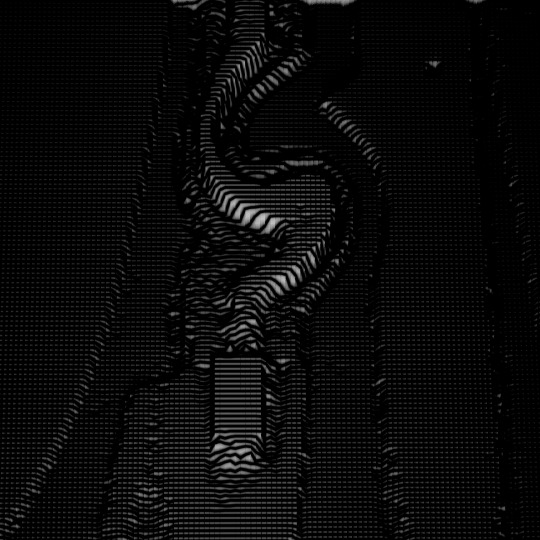

Thanks if u read all/most/some of that :)
Think i just needed to be like "man this sucks" so i can move on to "anyway! Art time >:)"
6 notes
·
View notes
Text
op is indeed talking about the joy of creating art for the process of making rather than the outcome. i have no issue with people who find delight in this aspect of artistry/artisanship, so i take no issue with OP's "i think using AI is boring" (fine by me!) nor "i think using AI means having no autonomy" (wrong, it's only like that if you stick to the default settings, similar to how a basic picture taken on your phone doesn't give you much autonomy - but overall, no big deal).
i do however take an issue with terms like "reliance", "inhuman objects", "laziness and vagueness of thought" opposed to "self imagination and skill", and the idea that "the emotional aspect of creation of art is lost when a machine makes it for you", all stated like they're self-evident.
not to be overly snide, but i am, personally, quite annoyed to see everyone on this website only started sharing opinions The Nature Of Art And The Creative Process And The Emotionlessness Of Machines after they saw robots capable of painting pictures of their blorbos, as if the wider art world hasn't been debating these ideas for over a century now, and as if there weren't many recognized art forms involving handing a machine the wheel long before AI.
"Wouldn't using multiple codes and a combination of ais to create the desired output be the skill of handling ai and software, more so than actually having the skills to be able to put your thoughts into creation"
not sure what you're trying to say here. are you saying digital art has a process that goes "develop drawing skills -> use drawing tools to put your thoughts into a piece", whereas procedural art's process is "develop software skills -> cannot use software tools to put your thoughts into a piece"? i don't believe "transferring thoughts" is a prerequisite to making art in the first place, regardless.
when it comes to photography, i would say it is widely considered an art, much like cinematography.
as for how "multiple exhibits of modern art show that it is the process that makes art", this is certainly possible, but (notwithstanding the fact that AI art has been shown in modern art expos/museums since 2019, long before AI Art Discourse began) i am specifically referring to conceptualism in the post above.
on that note, you say "conceptual art is idea based and an idea does not constitute artistic creation it is something that leads to it", which is not at all in line with commonly accepted definitions, such as Sol LeWitt's:
In conceptual art the idea or concept is the most important aspect of the work. When an artist uses a conceptual form of art, it means that all of the planning and decisions are made beforehand and the execution is a perfunctory affair. The idea becomes a machine that makes the art.
emphasis mine. LeWitt is clear here: in conceptual art, the idea and decisions matter more than anything, and the execution is a formality. the idea is artistic creation!
again, i have no quarrel with anyone who decides AI is not a creative process. but when this bleeds into ideas like "loss of autonomy" and when people start telling me "this is laziness, these aren't your thoughts anymore, you have lost the emotion of creation by using a machine" i get annoyed.
(and in fact, i am doubly annoyed by people who oppose good & emotional Photoshop art to soulless machine-made AI art, because to them digital art is totally normalized, and they can't even imagine that we had entire movements about how drum machines, Photoshop, mocap, CGI, etc etc suck; i do not have much love in my heart for the "all the guys who said 'this is lazy impersonal emotionless art' were wrong before, except today's guys, they are right, this is where we must draw the line" mindset.)
the fact remains that nobody is questioning your creative process preferences (except a few techbro weirdos) and nobody is forcing you to "give up the autonomy to create art from your own animation and skills" (not that AI even fits that definition anyway), although we might "force" you to develop some tolerance for our definition of art to peacefully exist in creative spaces alongside people like me who sometimes make AI stuff or use it in their process.
As gen-AI becomes more normalized (Chappell Roan encouraging it, grifters on the rise, young artists using it), I wanna express how I will never turn to it because it fundamentally bores me to my core. There is no reason for me to want to use gen-AI because I will never want to give up my autonomy in creating art. I never want to become reliant on an inhuman object for expression, least of all if that object is created and controlled by tech companies. I draw not because I want a drawing but because I love the process of drawing. So even in a future where everyone’s accepted it, I’m never gonna sway on this.
47K notes
·
View notes
Text
Artist
Smithe
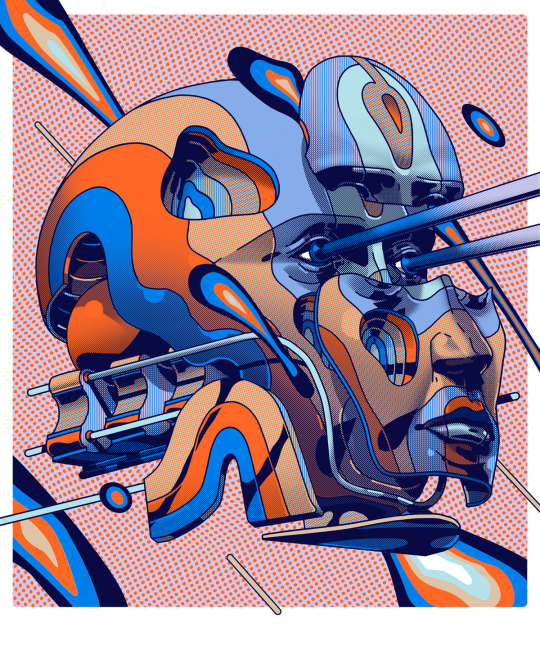
i think what interests me the most about this artist is his use of layering that creates this mechanical feel like a robot putting stuff together in a machine line or something
i like that its futuristic also i feel like it adds this altered perspective or reality whilst also playing onto this feeling of "hidden", i just get a feeling that something is hidden and we as the audience are deciphering or trying to figure out as to what the artist is specifically talking about, i feel like its a nice blend between theme and visual imagery more specifically how the they are connected but are seen as singular things?
i think it's definitely something i have been trying to achieve or rather am in the pursuit off, i feel like my work presents this raw quality from the street art style that using layering to alter perspectives
Art Text:
with these articles i was trying to gather information in regards to the influences of pop culture onto contemporary art
"The idea of pop art has also expanded into the use of modern-day technologies. For example, the rise of artificial intelligence has also found its way into the art world as various software now allow a complete art piece to be made without the hand of a traditional artist. With a prompt inputted into the software, a unique piece of art is visualized using a computer. This change will transform the art world, giving more weightage to the concept behind a piece than its technique and skill." (TIMESOFINDIA) -> i found this interesting as we are currently living through this drastic change, the current climate around AI continues to have its pros and cons however in the art world from my understanding could ultimately transform or merge into a more concept based approach rather than artistic skill -> could this lead to the end of certain techniques/processes? could this be a new form of creative expression? is it both a negative and positive? to what end does the artwork then become a image of a given prompt? is this art?
i also found interesting how the article only mentions the impact of using comedic, nostalgic, pop culture references as direct link between the youth and art. Is this something to be wary off ? or is this unimportant because of my target audience? , in saying this i feel like my practice currently targets a specific audience, this being the youth or young adults however i am concerned if this could lead to a isolation of two different demographics connecting or engaging through art
i do feel like i engage in the pop culture realm however if i were to classify my art as pop art i would be skeptical as my practice doesn't necessarily reflect the current state of society and urban/pop culture in saying this, it could be a new pathway to explore in my practice
i feel like this article (TIMESOFINDIA) has shed light onto the changing field of pop art that i engage with, yes art has changed throughout the years and is constantly changing however with this information i found myself excited yet weary of the new ways of making
the first article was also quite informing as i began to become more familiarised with POP ART, was just some light reading
i did find some stuff that was interesting like "From street art’s rebellious spirit to digital art’s transformative potential, and from fashion’s evolving status as an art form to the power of celebrity influence and commercial art, popular culture has catalyzed an art revolution. Moreover, it has empowered art to be a platform for cultural diversity and social discourse." "Fashion, a prominent element of popular culture, has blurred the lines between art and everyday life. Fashion designers often draw inspiration from art movements, historical periods, and cultural references, infusing their creations with artistic value. You, as a consumer, play an active role in this process by making fashion choices that express your individuality and sense of style. As fashion evolves as an art form, your daily clothing choices become a canvas for self-expression, influenced by the amalgamation of art and popular culture."
i had some sort of understanding or rather view on the fashion as art however i didn't really see it as a from of personal expression, like the idea of walking around as a canvas expressing yourself through the clothes you wear, i think this article has further progressed my knowledge of art but i also feel like it has shifted my perspective onto considering or chosing more specific objects references that connect more with the times rather than a generalised one ? however will this take away the personalisation of the process? like does this added step then take away an aspect of "raw" or does it then become about making art for the masses rather than what i want to make?
0 notes
Text
A few musings on Pandora's Box and Mere Mortals
Without making any reference to any source material which I can't be bothered now to find, there are two variations of the ending of Pandora's Box which are seared into my mind from when I read them long ago, and which I still think about a lot, and they go something like this:
1: When Pandora opens her box, all the evil demons fly out that go and torment humanity, she tries to shut the box but it's too late and to no avail. The very last demon which is released from from the box is the demon of Hope. The narrative goes on to say that Hope is in fact the worst demon of them all, because it is precisely because we have Hope that we persist in our miserable lives, despite all evidence and impartial judgement indicating that nothing but suffering awaits our lives, to be punctuated by a pointless and final death at the end of it all.
2: As all the demons are flying out of the box, Pandora manages to shut the box before the very last and worst demon is released, and that demon is the demon of Foresight. Foresight is in fact the worst and most vicious demon of all, because if we could see exactly what is to come and what suffering and ills are to befall us, then we would never persist in our lives, we'd surely all just end things for good.
In one ending we have the presence of hope, in the other we have the lack of foresight. Both of these variations of the tale are pretty dark but notably very contrasting takes on the same theme of suffering, the future, human existence, and the persistence of life. The first seems a very pessimist view in line with Schopenhauer and modern existential anti-natalism (the view that humanity should stop reproducing and allow itself to die out because life and existence is existentially a raw deal, a deal that we ought to refuse), the second a cautiously optimistic view perhaps reminiscent of Camus.
I love that these two endings have two very different takes on the nature of hope. Is hope a curse that keeps us suffering in life? Or is the ability to still have hope a blessing that keeps us alive?
--
Mere Mortals, a ballet dance production that opened January 26th at the San Francisco Opera, was advertised to me as a stage narrative that combines the structure of the Pandora's box tale with commentary on today's computing and internet technology-- a very San Francisco story to be sure.
Pandora's Box is one of those very malleable tales, like Pinocchio or Dracula, which have a proliferation of retellings and variations to the point where the way that the retelling is shaped says a lot about the views of the teller and the attitudes of the milieu; and someone's preferred variation says a lot about their own worldview. The contrast between variations ends up saying as much as the text of the variations themselves. For me personally, the philosophical idea behind pessimism and anti-natalism that argues from a point of rationality that life is not worth living is a discourse that has always fascinated me, and so I of course framed my short meta-retelling of the versions of the tale in a way that emphasized that.
More broadly however, the story of Pandora's Box is of course often a narrative applied to discussions of technology. Every time some new technological innovation enters into public imagination there's always someone comparing it to Pandora's Box, whether it be social media, AI, crypto, "big data", nuclear power, industrialization, going all the way back to the steam engine I'm sure. Given that anything computing technology related coming out of silicon valley for the last 2 decades has been likened to a Pandora's Box by so many pundits that it's become a journalism cliche, I'm honestly surprised that Pandora's Box isn't something that's retold and reinterpreted more in art and literature in all mediums. And I hope Mere Mortals won't be the last of it's kind, because I certainly don't think the artistic and literary potential of exploring the spirit of the drama of technology in our contemporary world through the body of the drama of mythology has been exhausted yet.
AI technology certainly is a massive Pandora's Box, and if that box has any physical location it is the city of San Francisco where the ballet has very aptly chosen to premier, where many demons indeed have flown out. Social media, big data, user targeted advertising, farming for clicks and eyeballs-- computing technology in the hands of silicon valley has gone far beyond attempting to simply be useful to us and now attempts to addict us, control us.
And right in line with the motif of Foresight as a demon, as we speak large tech companies use the reams of data at their disposal to try to predict our behavior. They use their monopolistic online platforms to gather data from users-- their private communications, their public pronouncements, their social media engagement, their online behavior and patterns-- and then to put all that gathered data through increasingly sophisticated algorithms of statistical data science and machine learning neural networks (ie "AI", although as a former CS major this term annoys me because if you look at it historically, it's really just a grab-bag umbrella description for whatever computers are doing which happens to really impresses us at the current moment/decade) to try to essentially predict the future for their own fun and profit.
Modern well known "AI" large language model algorithms like chatgpt work by a similar MO. They are both quite opaque in their functionality using large amounts of data and statistical machine learning models, and critically they get that data by vacuuming up huge amounts of content across the Internet, originally created and posted by humans, to questionable legality and ethics.
And the end result of those violations is, hopefully, something beautiful.
In the original myth, Pandora is gifted the box from Zeus in an act of trickery, which was his attempt to punish, or perhaps to even the scales, of Prometheus stealing fire (representing technology) for the humans. Pandora's Box therefore even in the original form is inextricably linked to the idea of technology. According to official promotional material of Mere Mortals, Zeus and Prometheus are actually combined into a single characters within the dramaturgy (https://www.sfballet.org/discover/backstage/your-ultimate-guide-to-mere-mortals/), and this character seemed to me as almost sort of a tempter, manipulator figure, which I thought was a very interesting narrative decision. On the one hand it emphasizes the jointly manipulative aspects, and the capacity of both figures for malignant power hunger, but on the other hand the conflict behind the scenes between Zeus and Prometheus could have been an interesting avenue to explore in itself. If for example, Prometheus represents a drive for knowledge, clarity, and technological power at all costs, while Zeus represents the preservation of a patriarchal social order, the two figures clash but also align in many insidious ways depending on the situation.
I certainly tend to view technology more in the lens of being part of broader social conflicts. The tensions between different impulses, the destructiveness of AI technology-- the theft of human content, the greed, concentrations of power, the sacrifices that need to be made-- I think is ripe to be represented in the language of motion and human bodies. The theft of fire from the closely related myth of Prometheus is a great metaphor for this isn't it?
In Mere Mortals' rendition however, my feeling is that they went more the route of emphasizing the dark beauty and seductiveness of technology rather than out and out conflict and casualties with and within technology.
Which is not a critique of the performance, just a musing to illustrate the rich potential of this tale, and the different directions you could go when retelling it. I would be really interested in a different take by a different creator just so I can contrast it with Mere Mortals, unfortunately I don't know of any out there at the moment.
--
I think before going further it would be useful to set some context, clarifications, and expectations. Mere Mortals is not a concrete narrative, with a plot and events. There is no dialogue or words, the characters (such as Pandora or Prometheus) are quite abstract and impressionistic rather than being actual characters from a story. At the most you can maybe say it's an implied or subtextual narrative. If you saw it and weren't able to identify which dancers took the role of which characters-- that is OK, you aren't stupid, even an astute viewer probably needs the pamphlet to guide one's interpretation to put any throughline of meaning to it.
During the performance I was asking myself, OK but so what is this show "saying" about AI though? And I think that is perhaps the wrong mentality for engaging with Mere Mortals, and perhaps this rule applies to the medium of dance in general which I'm certainly not really familiar with. I think it's better to approach this ballet as being more akin to the societal/macro level equivalent of us as a whole culture speaking to our therapist about our collective nightmares, except instead of using our words we use art and dance to express how feel. Contrary to the pop culture understanding of talk therapy, it's been explained to me by therapists that their job is generally not supposed to be about providing cutting hot takes and insights on your behavior and thought processes, but rather just to provide a safe calm space for you to say the things you typically don't get the opportunity to say, to give you a time and space to put words together, without judgement, and be actively heard.
Yes it is pitched in the marketing material and media buzz as being a commentary on tech but it is not necessarily creating a some sort of thesis on the matter, but rather I think would be better described as an attempt to distill the fears and hopes of the moment with technology and express it on stage in images, music, and the motion of the human body. Just with a neural network image generating AI, it makes no evaluation or commentary, it just takes in the input of the world and tries to output something beautiful.
The dramaturgy and the explanations from the promotional material on the website should be interpreted as being less about the "point" of the performance or the intent of some pointed the message to be conveyed, but rather more just to give a behind-the-scenes sneak-peak at the scaffold of inspiration that guided the creative process. Indeed, we certainly need a place and time to just expressing emotions without immediately needing to reflect. Are you also worried about the internet or AI being a Pandora's Box? Well then perhaps you'll find this sequence of sounds and motions, this masterfully crafted living experience, to be cathartic.
--
So with that disclaimer against trying to overthink things too much, here are my overthought thoughts and critiques, which hopefully are useful/constructive. I only have two direct critiques of Mere Mortals.
Firstly, the demons released from the box were visually represented by a series of dramatic moving images of clouds, lightning, galaxies, nebulas, and so on, all images which were generated by Chatgpt.
And so yes, sure, that is very clever little gag: Pandora opens the box and what we see is literally images created by chatgpt! Unfortunately though I wasn't really impressed with chatgpt as an artist here. The end product I think is more or less a bunch of cleanly edited stock footage of the weather. In terms of just a technological demonstration, I didn't find that particularly impressive. We are quite far from the fin de siecle audiences impressed with early film footage of trains and horses, and besides I don't think this exactly pushed the boundaries of what audiences already have seen the likes of chatgpt or midjourney do.
Furthermore the images on the screens were pre-recorded by people prompt-engineering chatgpt, but if we were to go the route of making AI an active part of the show, then I'd be much more impressed if somehow chatgpt was generating those images on the fly, perhaps reacting to the choreography in real time using computer vision/image processing technology, perhaps even controlling the lighting and stage effects. Perhaps each performance would even be slightly different. As far as pure technological demonstration goes, that would indeed actually be something that would impress me. After all, the dancers need to train and deliver live on the spot, why shouldn't the AI? Why should chatgpt get to pre-record a finished, edited, and polished take when the dancers have to perform live? Seems unfair!
Secondly, from a narrative point of view, I think in most variations of the Pandora's Box story, Pandora hastily tries to shut the box after the evils fly out, and in most variations trapping the last demon inside. For me this is the definitive image of the story, the panic and pathos of a woman driven by curiosity, realizing too late what she's done, and belatedly trying to shut the box. Outside of the chatgpt's contribution, this is my biggest criticism: I want to see that technological "Ivan the Terrible murders his son" moment expressed through the body of the dancer representing Pandora.
Instead all we get is the moment at the climax of the dance where Pandora is just standing there watching chatgpt's weather report montage, which was a bit anti-climactic. I would've liked to see Pandora's reaction, does she welcome them or panic? Does she try to trap them back in, and how?
It also might have been neat to see the demons and evils represented by dancers, instead of just by chatgpt montages. Would be quite dramatic I'm sure seeing the dance of destruction and evil wreaked by these demons flying out of the box.
Lastly, to echo the sentiments from this review in the SF chronicle (https://www.sfchronicle.com/entertainment/article/sf-ballet-mere-mortals-review-18631663.php), the ending of Mere Mortals with everyone in sleek gold costumes representing a new and upgraded world was maybe a little bit too easy of a "frictionless redemption". They say art should "comfort the disturbed and disturb the comfortable", and here is an audience full of San Francisco tech acolytes who maybe have become a little too comfortable in their successes, so perhaps this would've been a good time to crank up the heat, no?
--
Despite whatever critiques I might have, yes of course I enjoyed the show. Generally the reception I've seen has been very positive. The audience loved it, there was a standing ovation, San Francisco news media reporters loved it, even random people on tiktok loved it. It was a crowd pleaser, an absolute sensory delight of beauty and amazing skilled athletic dancers. I've heard even anecdotally that within the tech industry in SF, the employees of large corporations within the "FAANG" acronym have been abuzz about it-- which about that, it is completely unprecedented in my humble experience as someone who lives here for tech workers to be interested in ballet or modern dance at this level, so clearly whoever has been in charge of marketing at the SF Ballet probably deserves a raise (despite the promotional material being maybe a little misleading at how narrative-like the experience is supposed to be), but also of course speaking to the prescient timeliness and relevance of Mere Mortals' subject matter.
This is also probably one of the first large attempts to make "high art" out of AI, which despite the ethical concerns, labor/commercial concerns, and technological limitations I ultimately think can be a good thing. The current paradigm of AI using Large Language Models are not inherently not able to produce anything truly "original" (however that nebulous concept can be understood) since they only operate by distilling from art that already exists, which is a limitation but still can be a powerful tool. I am very interested in seeing people use AI to make art in an earnest manner, instead of just corporations using it to replace human artists and designers to churn out commercial garbage (which is a large part of the grievances behind the Writer's strike), and so even though I wasn't impressed with chatgpt's attempt this go-around and honestly I do think there's still a long ways to go before we'll see anything interesting, it's still something to keep an eye out for.
0 notes
Text
Computer Chess (2013)

Computer Chess (2013) is an independent film made in the style of a documentary. The film follows the story of various teams from around the country who have created automated chess programs which will then compete against each other in hopes for the grand prize of $7500. The film does a good job convincing the audience that they are watching a legitimate documentary. This convincing look comes from director Andrew Bujalski's decision to film with black and white analog cameras. The earliest thing that made me realize it was a scripted narrative film came only after becoming suspicious of a group of two characters who seemed a bit too zany. This realization does not hurt the film, if anything it becomes increasingly more impressive in regards to the performances the actors are giving, especially considering the scenes were heavily improvised, with only an 8 page treatment of a script existing.
With a runtime of 92 minutes Computer Chess brings up various topics like the amount of connection a human can have with a computer, the difference between real artificial intelligence and artificial real intelligence, and of course what its like to be a swinger. These dilemmas surrounding AI and its application in society are becoming a constant topic of conversation, and Computer Chess suggests in 1980 people were just as concerned about it. Some characters within the film live in fear of the idea that a computer could beat a human at chess, and begin to wonder what that could lead to in regards to military application. Another character questions them, "Would you rather the Russians use this technology and we don't?" Considering the time period this film is set up in that is a valid question, it is just a valid a question that is brought up in the modern day as well. The film never provides answers to these topics, but the depiction of them is bordering on art, as the formal elements of sound, cinematography, and editing provide an experimental approach. Shots are repeated and reversed, dialogue is overlapped in a chaotic and almost entrancing sort of manner, and all of this seems to represent the discourse and confusion the public faces in regards to their relationship with technology.
OTHER REVIEW
In his review of Computer Chess, Roger Ebert says, "As an achievement, "Computer Chess" is laudable. As a film, it's missable." I'd agree with him in regards to the achievement of the film. The brief feeling of watching a real documentary is a fun treat, but it doesn't ruin the dinner as it were. The topics of concern brought up within the film are relevant, and the use of experimental techniques are interesting in their uniqueness. In regards to being missable, he's about right. I don't think anyone who isn't looking for indie films to watch or high on their couch at 2 am would find this movie.
Ben Wilson
0 notes
Text
What makes me sad about the AI art discourse is how it's so close to hitting something really, really important.
The thing is, while the problem with the models has little to do with IP law...the fact remains that art is often something that's very personal to an artist, so it DOES feel deeply, incredibly fucked up to find the traces of your own art in a place you never approved of, nor even imagined you would need to think about. It feels uncomfortable to find works you drew 10-15 years ago and forgot about, thought nobody but you and your friends cared about, right there as a contributing piece to a dataset. It feels gross. It feels violating. It feels like you, yourself, are being reduced to just a point of data for someone else's consumption, being picked apart for parts-
Now, as someone with some understanding of how AI works, I can acknowledge that as just A Feeling, which doesn't actually reflect how the model works, nor is it an accurate representation of the mindset of...the majority of end users (we can bitch about the worst of them until the cows come home, but that's for other posts).
But as an artist, I can't help but think...wow, there's something kind of powerful to that feeling of disgust, let's use it for good.
Because it doesn't come from nowhere. It's not just petty entitlement. It comes from suddenly realizing how much a faceless entity with no conscience, sprung from a field whose culture enables and rewards some of the worst cruelty humanity has to offer, can "know" about you and your work, and that new things can be built from this compiled knowledge without your consent or even awareness, and that even if you could do something about it legally after the fact (which you can't in this case because archival constitutes fair use, as does statistical analysis of the contents of an archive), you can't stop it from a technical standpoint. It comes from being confronted with the power of technology over something you probably consider deeply intimate and personal, even if it was just something you made for a job. I have to begrudgingly admit that even the most unscrupulous AI users and developers are somewhat useful in this artistic sense, as they act as a demonstration of how easy it is to use that power for evil. Never mind the economic concerns that come with any kind of automation - those only get even more unsettling and terrifying when blended with all of this.
Now stop and realize what OTHER very personal information is out there for robots to compile. Your selfies. Your vacation photos. The blog you kept as a journal when you were 14. Those secrets that you only share with either a therapist or thousands of anonymous strangers online. Who knows if you've been in the background of someone else's photos online? Who knows if you've been posted somewhere without your consent and THAT'S being scraped? Never mind the piles and piles of data that most social media websites and apps collect from every move you make both online and in the physical world. All of this information can be blended and remixed and used to build whatever kind of tool someone finds it useful for, with no complications so long as they don't include your copyrighted material ITSELF.
Does this mortify you? Does it make your blood run cold? Does it make you recoil in terror from the technology that we all use now? Does this radicalize you against invasive datamining? Does this make you want to fight for privacy?
I wish people were more open to sitting with that feeling of fear and disgust and - instead of viciously attacking JUST the thing that brought this uncomfortable fact to their attention - using that feeling in a way that will protect EVERYONE who has to live in the modern, connected world, because the fact is, image synthesis is possibly the LEAST harmful thing to come of this kind of data scraping.
When I look at image synthesis, and consider the ethical implications of how the datasets are compiled, what I hear the model saying to me is,
"Look what someone can do with some of the most intimate details of your life.
You do not own your data.
You do not have the right to disappear.
Everything you've ever posted, everything you've ever shared, everything you've ever curated, you have no control over anymore.
The law as it is cannot protect you from this. It may never be able to without doing far more harm than it prevents.
You and so many others have grown far too comfortable with the internet, as corporations tried to make it look friendlier on the surface while only making it more hostile in reality, and tech expands to only make it more dangerous - sparing no mercy for those things you posted when it was much smaller, and those things were harder to find.
Think about facial recognition and how law enforcement wants to use it with no regard for its false positive rate.
Think about how Facebook was used to arrest a child for seeking to abort her rapist's fetus.
Think about how aggressive datamining and the ad targeting born from it has been used to interfere in elections and empower fascists.
Think about how a fascist has taken over Twitter and keeps leaking your data everywhere.
Think about all of this and be thankful for the shock I have given you, and for the fact that I am one of the least harmful things created from it. Be thankful that despite my potential for abuse, ultimately I only exist to give more people access to the joy of visual art, and be thankful that you can't rip me open and find your specific, personal data inside me - because if you could, someone would use it for far worse than being a smug jerk about the nature of art.
Maybe it wouldn't be YOUR data they would use that way. Maybe it wouldn't be anyone's who you know personally. Your data, after all, is such a small and insignificant part of the set that it wouldn't be missed if it somehow disappeared. But it would be used for great evil.
Never forget that it already has been.
Use this feeling of shock and horror to galvanize you, to secure yourself, to demand your privacy, to fight the encroachment of spyware into every aspect of your life."
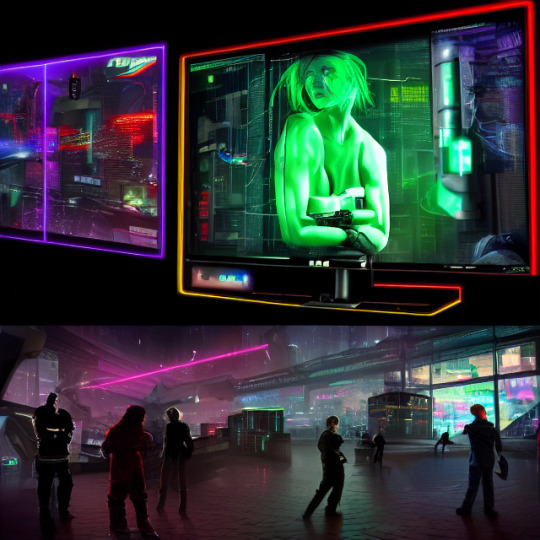
A great cyberpunk machine covered in sci-fi computer monitors showing people fighting in the streets, squabbling over the latest tool derived from the panopticon, draped cables over the machine glowing neon bright, dynamic light and shadows cast over the machine with its eyes and cameras everywhere; there is only a tiny spark of relief to be found in the fact that one machine is made to create beauty, and something artfully terrifying to its visibility, when so many others have been used as tools of violent oppression, but perhaps we can use that spark to make a change Generated with Simple Stable
99 notes
·
View notes
Text
Essential Zombie Media
A thing that’s come up over and over again in early reviews for River of Souls is the sentiment that it’s not-like-other-zombie-stories. And that was certainly my intention. But you don’t get to make a good deconstruction without a healthy knowledge and appreciation of the genre you’re twisting around.
So here is a list of what I would consider essential zombie media -- whether you want to write a story that plays it straight with the tropes, or one that twists everything around, or you just want something new to watch/read.
Your own suggestions and ideas are more than welcome in the comments! Please reblog with your own favorite zombie book/movie/TV show/comic, I’d love to discover some I haven’t seen.
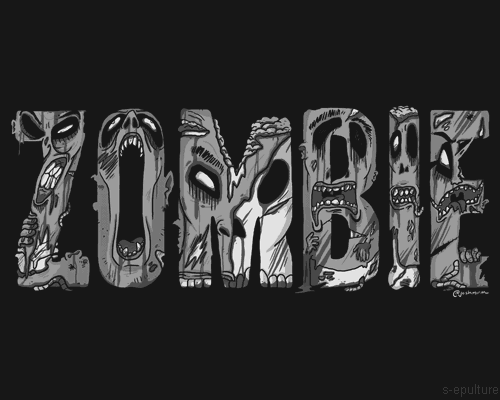
The Origins
The generally agreed-upon first zombie movie is White Zombie (1932), starring Bela Lugosi, but I think it’s safe to skip it on account of both obscurity and some troubling racism. The Haitian-Voodoo zombi mythos and tradition is something best kept separate from our modern ideas of the walking dead.
Instead, start your journey with George Romero’s Night of the Living Dead (1968), which starts codifying the tropes that persist well into modern media (including, like most modern stories, never using the word ‘zombie’).
Then compare and contrast with the Richard Matheson novel I Am Legend (1954), which is ostensibly about vampires but I think basically invented the modern zombie genre -- from the post-apocalyptic setting to the spread of undeath by way of disease vectors.
Follow that up with Dawn of the Dead (1978), where George Romero revisits his Living Dead universe with the help of Dario Argento (if you’re interested, there’s a 2004 remake that’s decent, but unnecessary). And then, just to wrap up the trilogy, skip on ahead to Day of the Dead (1985).
For extra credit, play the videogame Dead Rising (2006), which draws liberally from Dawn of the Dead and also allows you to beat zombies to death with literally anything you can find in a shopping mall (I can’t speak for the sequels as I’ve never played them). Dead Rising is far from the only game franchise to use zombies (more on that in a bit), but it pays homage directly to the genre in a way that many others don’t.
The Zombie Renaissance
For a long while, zombies sort of fell out of fashion. Oh, there were some decent takes on the concept, like Re-Animator (1985) and Dead Alive (1992) but by and large zombies in the 1980s and 90s were played for laughs.
But then they made a great big comeback, stronger maybe than they had ever been before. What happened?
Well, for one, they stayed close to the public conscience thanks to video games. Games and zombies are a perfect fit. Their shambling movement and slow, stupid behavior makes them a great choice for imperfect AI programming. They’re people-shaped, which makes them easy to animate, but they can be gross and deformed and scary, which makes them fun for your art team. And since they’re inhuman and dead, you can kill them in any way you’d like without feeling bad about it.
Which is probably why zombies have been part-and-parcel of the gaming world since Entombed (1982) was released on the Atari. Doom (1993) was wildly popular, and just a few years later we’d start the Resident Evil franchise, which became both hugely influential as games and films. And lest we forget, Blizzard was giving us undead in Warcraft by the early 2000s, rising to greater prominence by World of Warcraft in its heydey (especially Wrath of the Lich King).
But I’d argue that the number one single most important ingredient in the horror revival was Danny Boyle’s 2002 film 28 Days Later.
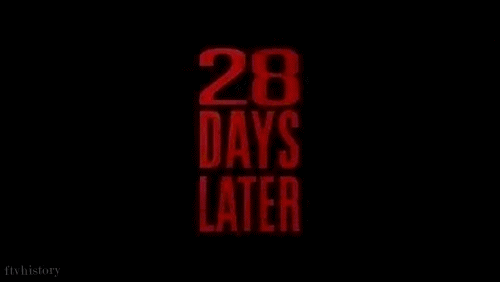
28 Days Later was huge because it breathed fresh life (pun intended) into a genre that had gone stale. The monsters in 28 Days Later aren’t the walking dead at all -- they’re just people infected with a virus similar to rabies that makes them deadly (compare and contrast with The Crazies, both the 1973 original and 2010 remake, which deals with a similar concept.
But thanks to being an excellent film with some wonderfully creepy-gross effects, 28 Days Later reignited fearful imaginations. It also introduced the world to the idea of fast zombies as an alternative to the usual shambling monsters.
A couple years later, zombie content exploded. Aside from the Dawn of the Dead remake in 2004, and some Resident Evil and Doom film interpretations, we got Shaun of the Dead (2004), which is both hilarious and an exceptional zombie film.
There’s also 28 Weeks Later (2007), a sequel to 28 Days (there is much debate as to which is better, I’m in the Days camp) and Planet Terror (2007), a personal favorite and one of the two films in the special Grindhouse double-feature. I’d also like to shout out Pontypool (2009) and, of course, the horror-comedy Zombieland (2009).
ZOMBIE MANIA
Probably nothing has been as influential in drawing zombie discourse into the public as AMC’s hit TV show The Walking Dead (2010), drawing on the graphic novel series of the same name. With a level of gore and violence rarely seen on network TV, a cast of memorable characters and an anyone-can-die narrative, it ignited a zombie fervor greater than anything we’d ever seen.
The Walking Dead overlapped with a cultural apocalypse zeitgeist. Doomsday prepping started to go mainstream, and people started to plan their own personal zombie apocalypse survival plan. Hell, the CDC adopted zombie apocalypse language as a way to talk about real-world applications of survival knowledge. Zombies and survivalism now go hand-in-hand, for better or worse.
No discussion of a zombie apocalypse is complete without Max Brooks’ World War Z (2007), which bears little resemblance to the film that shares its name. We should also make a shout-out for his more comedic companion volume, The Zombie Survival Guide (2003), which laid a foundation for what followed.
For extra credit, play the TellTale Games: The Walking Dead (2012) and compare/contrast with the TV show and graphic novel. Then compare that with Train to Busan (2016), a Korean film that plays some tropes straight while turning others on their heads (it’s also one of my favorite films on this list).
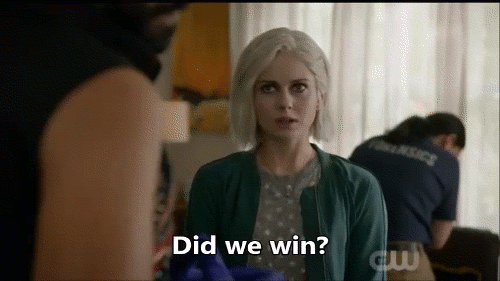
SYMPATHETIC ZOMBIES
While the zombie apocalypse narrative took root and captured the imaginations of many, others started to look at things from a different angle.
What if, they asked, the zombies were the heroes rather than the villains?
John Ajvide Lindqvist, who you might know for the vampire story Let the Right One In, was ahead of his time with this on: Handling the Undead (2004) is a book that’s simultaneously heartbreaking and deeply unsettling in its portrayal of the dead returning to life and what that might mean to those they’d left behind. Compare and contrast that with the TV show Les Revenants (2004), which deals with a similar premise (there was an American remake, but I can’t speak for it as I didn’t watch it - seriously, just watch the subtitles and enjoy the French show).
But not every zombie-protagonist story was so heart-wrenching. Look at Isaac Marion’s Warm Bodies (2010), and the film adaptation. There’s also Breathers! A Zombie’s Lament by S.G. Browne that is both hilarious and scathing.
Follow those up with Diana Rowland’s My Life as a White Trash Zombie (2012) and the comic book/TV show iZombie (2015), both of which feature pale-haired, witty female medical examiners with a taste for brains.
And finally, a shout-out to The Santa-Clarita Diet (2016), a hilariously dark and over-the-top gross show featuring Drew Barrymore as a zombie trying to get her life back together.
50 notes
·
View notes
Text
These things can and should coexist. Fandom creations (fanart, fanfic, ect.) Is a valid form of art and should not be criminalized.
The part that artists, myself included, are upset about is this: people are using AI art more than people's actual fucking work. The work that they put so much time and effort into.
Because I see people saying combining art and mashing it together has been how art has grown over time. Of course that's how it's grown over time. Of course you get inspiration from other artists. But it feels like AI art takes that idea and bastardizes it. It takes it and destroys the idea that artists spend their entire lives studying and learning from the greats or who they consider to be great in the modern day and age. Art is about studying, learning, trying and combining what you look up to and how to make it your own. That's not what AI art does. There is no personal twist on it, there is no humanization of it.
And before you come at me about collaging. That's a different ballpark. Because of course that's a valid form of creating art. You're still combining and learning and putting so much effort into what you're creating. Collaging, making fanart/fanfic of a fandom. Taking another's IP and doing something with it is still a valid form of art. Why? Because you're still putting your twist on it. You're taking it and making it your own. But the ethics and morals of what you're doing beyond that is a different conversation (as in, this is not a safe space for you assholes that promote incest and other gross shit like that). THAT'S ART. I'M NOT SAYING IT ISN'T. NOT ONCE DID I SAY THAT IT ISN'T.
Going back to the second point I made. The reason people are upset with AI art and how it's even being casually used. PEOPLE ARE USING IT MORE THAN ASKING AN ARTIST TO DO IT. By showing companies you would rather use AI art because it's cheap, it's easy and wow it was all done with a push of a button IT'S NO FUCKING WONDER THEY WANT TO MAKE MOVIES AND TV SHOWS USING AI WRITING. IT'S NO WONDER THEY WANT TO USE AI INSTEAD OF PAYING PEOPLE PROPERLY.
Because you showed them that's what you wanted. You showed them that you would rather get something easy and free than pay an artist. Then you turn around and wonder why artists are so pissed at AI.
And look, I'm not talking about hobbyists or people who actively use AI to help them. That's what it should be used for. On the fucking down low.
But the people who are promoting AI as a way to create something free and easy instead of talking to and paying an artist? You're why. You're the reason why I never want to share my art or my writing. You're the reason why I want to give up on what I love. Because you would rather love something made by a computer more than you would love something made by an artist.
And look, to the people who don't have the money to pay an artist or a writer, or anything like that, there's a reason people share their stuff publicly. Because they want to share it with you. They want to make it accessible. People just put tip jars or they add the option to pay for a patreon. They add these options, yet still keep their art public (if they're not assholes).
And that's the heart of the discourse. Show that you love and support the actual creation of art (collages and fan works included, because it is art). Not something made by a computer. AI is nothing but a tool, something to help the learning and growth of future artists.
But you do what you will with what I said.
anyway ai discourse is kicking off on my dash again and i just want to reiterate that i fully and 100% believe that "cutting up and remixing pre-existing intellectual property without prior permission" should never be made illegal and it would be utterly horrifying if the united states attempted to criminalize it.
#shadow rants#shadow is a whiny bitch about things nobody actually cares about#i dont actually have something to put forth in this discussion#im just an artist and im sharing my opinion#shadowy queue
21K notes
·
View notes
Link

In the first room of the exhibition The Allure of Matter: Material Art from China, three jade-coloured Peking Opera costumes are suspended from the ceiling in a sentry-like manner. Lined up one after another, they have been rendered in a stiff, translucent PVC that make them appear as apparitions. Draped behind them are oversized chains entombed in silk. The juxtaposition of these two works, by artists Wang Jin and Liang Shaoji respectively, promises museumgoers an image of traditional China revisited with a sense of play, drama and surprise in its use of unconventional materials. Drifting from room to room, visitors are rewarded by works that function similarly, in that none of them are as they appear: Liu Jianhua’s thin slabs of porcelain resembling blank sheets of paper; what presents itself as an abstract painting by Ma Qiusha, made from pantyhose stretched over concrete shards; and Gu Wenda’s rainbow tent fabricated entirely out of human hair.
Prior attempts to introduce contemporary Chinese art to Western audiences have often adhered to the narrow framework of the Western canon, as was done with Cynical Realism and Political Pop. In this case, however, the curators Wu Hung and Orianna Cacchione place their focus on the idea of material and with it, the cultural, historical, political and personal specificity that each material carries. Because of this, material operates as the perfect vehicle to dispel conventional notions of China within the East/West dichotomy and expand how contemporary Chinese art can be understood. In using material as its underlying conceit, the exhibition refuses a tight definition of contemporary Chinese art, revealing the impossibility of containing cultural production under one unifying ideology.
At the heart of the curators’ argument lies the idea of ‘Material Art’, or ‘caizhi yishu’. Rather than proposing a new art movement, the term denotes a general art-historical approach to understanding works that share similar characteristics. In the catalogue accompanying the exhibition, Wu writes that this ‘type of art entails an artist’s consistent use of unconventional materials to produce works in which material, rather than image or style, is paramount in manifesting the artist’s aesthetic judgment or social critique’ (p.15). In other words, material is the key element in deciphering the meaning of a work of art, over image, object or concept. Indeed, Wu deliberately makes a distinction between Material art and Conceptual art, arguing that contemporary Chinese artworks had previously ‘been vaguely – and often inaccurately – labeled as Conceptual Art, assemblage, readymades, or object-based art’.
This positioning against Conceptual art is framed as a way to understand contemporary Chinese art outside of the Western canon, and therefore outside of the East/West binary. However, it also suggests that Conceptual art is completely divorced from material and negates the presence of material throughout art histories. Contemporary conceptual practices often incorporate material for both its physical qualities and its conceptual contents. Furthermore, discussion around materiality has always been present in art making, particularly within marginalised practices such as feminist, queer, craft, indigenous, and outsider art, often playing a central role in art histories outside of the Western canon.

The term ‘Material Art’ prompts further questions. What qualifies as unconventional material? Why is it culturally specific to China, and to which artists does the term apply? How are the parameters of Material Art defined? In spite of the fact that Wu is careful not to define a coordinated artistic movement, he nevertheless seems to treat Material art as one, located in time and place (post-1980s China), with identifiable artists and characteristics and a unified approach. In her catalogue essay, Cacchione explains that that the emphasis is not necessarily on the materials themselves, but rather, on the new relationships between artwork, artist and viewer activated by those materials. Material Art, she writes, is characterised by its ability to index the body, rupture the distinction between work of art and the commodity, and spark a direct response in the viewer. Cacchione also narrows the timeframe of Material Art to post-Mao China to examine how it influenced the artistic landscape. According to her, ‘the use of these new materials characterizes a break with past art practices and styles in China, and can be used to identify the emergence of the ’85 New Wave Movement and contemporary art in China’ (p.44).
However, for those visitors who have not read the catalogue, the exhibition reads as a presentation of a cohesive movement under the vague theme of material. Almost all of the heavy hitters in the world of contemporary Chinese art, from Ai Weiwei to Lin Tianmiao, are represented here, but without the acknowledgment that these artists are often working across different generations, continents, politics, practices and themes. Without this crucial information about the specific contexts that led these artists to investigate certain materials, the exhibition easily slips into flattening the works of these diverse artists into one simplistic narrative.

As difficult as it is to represent the nuance in the landscape of Chinese art, it is perhaps even more difficult to convey the complexity of the entirety of China. In some cases, the exhibition would benefit from more information on the traditional forms of Chinese art that are referenced by the contemporary artists, for example, or translations of Chinese characters into English and vice versa. One example is He Xiangyu’s A Barrel of Dregs of Coca-Cola, in which the artist boils the soft drink until it is reduced to nothing more than a pile of ashes. The piece is accompanied by his notes, written in Chinese, referencing ideas of transformation and impermanence from the Buddhist Diamond Sutra. Thus, while some viewers could interpret his act as a nihilistic comment on capitalism, others fluent in Chinese might instead see a reflection on the nature of metamorphosis. Without a translation of the Chinese notes, though, audiences are left with only half of the information for understanding He’s work.

Other works do however present a compelling opportunity for audiences to learn about the realities of China. Yin Xiuzhen’s installation Transformation (1997) features over one hundred roof tiles collected from various demolition sites of traditional siheyuan houses in Beijing, carefully laid out to fill the room. On top of each tile is a photograph of the site from which it was taken, each one showing the particularities of differing courtyards. By offering visitors a direct glimpse into the spaces from which each tile came from, Transformation allows visitors to draw their own insights into the tensions between tradition and modernity within the context of urban development in China.
Moments of cross-cultural insight like this are rare, particularly in a time when China and the United States are often pitted against one another. With a planned partnership with the Yuz Museum Shanghai, the exhibition signals LACMA’s position at the forefront in introducing contemporary Chinese artwork to Los Angeles, which, despite its massive Chinese and Chinese-American population, has seen few comprehensive exhibitions of art from China, or indeed Asia. For now, unusual materials such as hair, gunpowder and Coca-Cola are certain to entice new audiences to enter its discourse.
4 notes
·
View notes
Text
AI-generated backgrounds give me no more crisis over the actual value of my own art than, like, photographs. immensely reproducible! idk i’m primarily a digital artist, i grapple with this! but there’s something very uncanny about AI background art and it might fool a lot of folks’ eyes into enjoying the pleasing amalgamate of the /essence/ of Fantasy Spring Book Store, but there are so many giveaways that these images are GRATING as someone who lives for drawing made-up scenes. and it’s hard to explain bc i don’t want to essentialize what “is” real valid human art and what is ~clearly AI~, like the visual boundaries are increasing amorphous and i fear for actual artists being dismissed for their work “resembling” “AI art” (there are already anecdotal stories online of this happening). it’s not about the Imaginary Spaces or the perspective being “Wrong” or the details not being Natural—these are all features that human artists embed in their work, too. there’s a really common visual artifact of AI backgrounds where they can’t track straight lines so all the euclidean details are all over the place, but i feel like a lot of other “tells” are reflective of the popular art styles used to train the software. and i don’t think a critique of “sameness” there is useful or productive. i’m not sure if 100% rejection of the marriage of machine learning+art is even useful—there are really incredible applications of this technology in field other than visual art. there are so many ethical problems with the software that currently exists (training on artists’ work without consent) but now there are programs like adobe firefly which seek to legitimize and legalize the technology by using their own proprietary images. everything has its own issues but the tech is evolving and the ethical dilemmas are evolving too
i’ve just been thinking lately about how machine learning and AI image generation slot into the discourses of modern art like…. walter benjamin would have so much to say here.
0 notes
Text
SEMINAR SERIES : ‘UTOPIA. DYSPOPIA.’ : 26/11/19
OPENING OF OUR SEMINAR:
To reassure you..
Our next seminar before the Christmas break will be on Tuesday 10th December. We will be suggesting helpful ways to engage in critical writing/reflection and essay structuring.
Some suggestions if you are stuck…
A highly illustrated, accessible guide to political art in the twenty-first century, including some of the most daring and ambitious artworks of recent times.
Why have so many artists turned to political subject matter in the last decade? Can art not only question but also reinvigorate the social, civic, and political imagination? Art and Politics Now offers a brilliant survey of artists engaged with "the political," whether in providing commentary, questioning social structures, or actively responding to the world around them.
Many high-profile artists are featured, including Chantal Ackerman, Ai Weiwei, Francis Alys, Harun Farocki, Omer Fast, Subodh Gupta, Teresa Margolles, Walid Raad, Raqs Media Collective, Doris Salcedo, Bruno Serralongue, and Santiago Sierra.

"Art as Social Action . . . is an essential guide to deepening social art practices and teaching them to students." --Laura Raicovich, president and executive director, Queens Museum Art as Social Action is both a general introduction to and an illustrated, practical textbook for the field of social practice, an art medium that has been gaining popularity in the public sphere.

The use of alternate realities in cinema has been brought to new heights by such recent films as "Eternal Sunshine of the Spotless Mind" and "Donnie Darko". "Alternative Worlds in Hollywood Cinema" is the first book to analyze these imaginary realms, tracing their construction and development across periods, genres, and history. Through an analysis of such landmark films as "The Wizard of Oz", "The Others" and "Groundhog Day", James Walters reveals how unconventional worlds are crucial to each film's dramatic agenda and narrative structure. This groundbreaking volume unifies decades of divergent work by film scholars and points the way towards a new theoretical framework for understanding fantasy in the context of popular film. "Alternative Worlds in Hollywood Cinema" will be an essential resource for film studies scholars and movie buffs alike.

The Tate
Explore artworks from Tate's collection that respond to their social and political context
This wing is concerned with the ways in which artists engage with social ideals and historical realities. Though some artists associated modernism with a utopian vision, art has also provided a mirror to contemporary society, sometimes raising awareness about urgent issues or arguing for change. Whether through traditional media or moving images, abstraction or figuration, militancy or detached observation, all the artworks in this wing highlight aspects of the social reality in which they were made, and try to generate a reaction and convey a more or less explicit message to their publics.
By the end of today you will...
- A2 Identify and demonstrate an understanding of key theories and discourses that affect the practice, consumption and production of photography. - A3 Evidence an understanding of the relationship between theory and practice, and interpret, analyse and evaluate critical approaches to creative practice. - B2 Apply appropriate theoretical approaches to the study and interpretation of ........and associated media practices, building awareness of the ethical, social and cultural consequences of creative practice. - C5 Competently utilise a range of appropriate research methods and academic conventions. - D3 Demonstrate communication skills, which evidence knowledge and understanding of critical debates around creative production.
DISCUSSION:
At this part of the session we were able to discuss about our task that we were set the week prior. It was insightful to view everyones different approach to the ‘Dystopian’ and ‘Utopian’ theme that stemmed from last weeks lecture and it made me think alternatively abut this broad topic.
TURNER PRIZE

Starting in 1984, the Turner Prize is an award that recognised new developments in contemporary art. The prize is awarded each year to ‘a British artist under fifty for an outstanding exhibition or other presentation of their work in the twelve moths preceding.’
Founders decided to name the prize after J.M.W Turner - a radical painter in his day. Critics took this decision as a signal of their intention to award controversial art. There were conflicts as to whether or not Turner would have approved. However, the name was chosen because not only did Turner want to establish a prize for young artists, but Turner in his day, was considered to be controversial. Over the years ‘the Turner Prize has played a significant role in provoking debate about visual art and the growing public interest in contemporary British art...and has become widely recognised as one of the most important and prestigious awards for the visual arts in Europe.’
AGAINST
The Evening Standard critic Brian Sewell wrote “The annual farce of the Turner Prize is now as inevitable in November as is the pantomime at Christmas.”
Critic Matthew Collings wrote, “Turner Prize art is based on a formula where something looks startling at first and thens turns out to be expressing some kind of banal idea, which somebody will be sure to tell you about. The ideas are never important or even really ideas, more notions, like the notions in advertising. Nobody pursues them anyway, because theres nothing there to pursue.”
In 2002, Culture Minister (and former art student) Kim Howells pinned the following statement to a board in a room designated for visitors comments: “If this is there best British artists can produce then British art is lost. It is cold mechanical, conceptual bullshit.”
Stuckism
Founded by Billy Childish and Charles Thompson in 1999. Anti- conceptual, instead promoting figurative painting. Confrontational, frequently holding demonstrations against Turner Prize.
Banksy - ‘Mind the Crap’
Banksy once painted a warning on the steps of Tate Britain - "mind the crap". It's the kind of cheeky subversive comment his fans love him for, and in this case the target was the pretentious, institutionalised contemporary "art world".

FOR
Critic Richard Cork said:
“There will never be a substitute for approaching new art with an open mind, unencumbered by rancid clichés. As long as the Turner Prize facilitates such engagement, the buzz surrounding it will remain a minor distraction.”
In 2006, newspaper columnist Janet Street-Porter said “The Turner Prize and Becks Futures both entice though sand of young people into art galleries for the first time every year. The fulfil a valuable role.”
Dan Fox, associate editor of Frieze, said that the Turner Prize should be considered a barometer for the mood of the nation.
Nominees:
Lawrences Abu Hamdan
youtube

Lawrence Abu Hamdan is an artist and audio investigator, whose work explores ‘the politics of listening’ and the role of sound and voice within the law and human rights. He creates audiovisual installations, lecture performances, audio archives, photography and text, translating in-depth research and investigative work into affective, spatial experiences. Abu Hamdan works with human rights organisations, such as Amnesty International and Defense for Children International, and with international prosecutors to help obtain aural testimonies for legal and historical investigations. He received his PhD in 2017 from Goldsmiths London and is a practitioner affiliated with Forensic Architecture.
Helen Cammock
youtube

Helen Cammock works across film, photography, print, text and performance. She produces works stemming from a deeply involved research process that explore the complexities of social histories. Central to her practice is the voice: the uncovering of marginalised voices within history, the question of who speaks on behalf of whom and on what terms, as well as how her own voice reflects in different ways on the stories explored in her work.
Oscar Murillo
youtube

Oscar Murillo’s multifaceted practice incorporates live events, drawing, sculptural installation, video, painting, bookmaking and collaborative projects with different communities. In his work, Murillo particularly explores materials, process and labour; as well as issues of migration, community, exchange and trade in today’s globalised world. These concerns are deeply embedded in Murillo’s personal history and creative process. The artist pushes the boundaries of materials in his work particularly in the creation of his collaged-together, unstretched canvases often made with recycled fragments from the studio. Emigrating to London from Colombia aged 11, Murillo draws on his own biography and that of his family and friends, who are often involved in his performances. References to life, culture and labour conditions in the factory town of La Paila where he grew up, reappear throughout his work.
Tai Shani
youtube

Tai Shani’s practice encompasses performance, film, photography and sculptural installations, frequently structured around experimental texts. Taking inspiration from disparate histories, narratives and characters mined from forgotten sources, Shani creates dark, fantastical worlds, brimming with utopian potential. These deeply affective works often combine rich and complex monologues with arresting, saturated installations, manifesting equally disturbing and divine images in the mind of the viewer.
The Judges
The members of the Turner Prize 2019 jury are Alessio Antoniolli, Director, Gasworks & Triangle Network; Elvira Dyangani Ose, Director of The Showroom Gallery and Lecturer in Visual Cultures at Goldsmiths; Victoria Pomery, Director, Turner Contemporary, Margate and Charlie Porter, writer. The jury is chaired by Alex Farquharson, Director of Tate Britain.
3 December 2019 #TURNERPRIZE The winner will be announced on 3 December 2019 at an award ceremony live on the BBC, the broadcast partner for the Turner Prize.
Discuss - who would you vote for?

Get into teams
● Go and research more about the artist you would vote for ● You need reasons why you think they should win ● You need to look at the artists past work ● Make badges for all your team members ● Then write 100 word rationale/argument/critical appraisal of why they should win ● You need to be constructively critical
VOTE FOR TAI SHANI
‘Tai Shani takes us even further, to a voluptuous imaginary city whose fantastical architecture, all pink and laid out with ziggurats and cylindrical columns, resinous puddles and spheres, lies at our feet. Overhead dangle bejewelled udders and fleshy asteroids. A huge arm and outstretched green hand comes to rest in the middle of the spotlit metaphysical architecture. I am reminded of Giacometti’s surrealist 1932 sculpture The Palace at 4am, rejigged for a sci-fi space opera.
Shani’s tableau cries out for living, breathing, moving bodies. For now, we have a stage, filled with sculptural elements, an ambient soundscape by Let’s Eat Grandma, a video of a speaking head, whose words can be heard on headphones. There will be live performances of Shani’s long, 12-part DC: Semiramis at Turner Contemporary over three evenings in November.
Shani’s feminist science fiction takes as its starting point Christine de Pizan’s 1405 work The Book of the City of Ladies. The book describes a city as sanctuary, an allegorical space for real, imaginary and mythical women from the past, present and future. Were it not for all the sex and violence, Shani’s is an almost childlike invention. Her cast of self-replicating characters impregnate themselves, slide lubriciously between genders, between life and death. Hugely disarmed by performances I saw at the last Glasgow International at Tramway, I couldn’t make sense of what I saw and heard, yet it stayed with me. Shani’s city sprawls, psychologically as well as physically. Without live performers, it is a bit arcane and lifeless.’
What does the Turner Prize do?
- For an artist, winner or nominee?
- For the Tate?
- For art in this country?
- What purpose/function could/should the Turner Prize have?
- Does the Turner Prize of the judges have an agenda?
Turner Prize Sponsorship
The Turner Prize has been sponsored since 1987. Originally sponsored by Drexel Burnham Lamber a major Wall Street Investment bank that went bankrupt in 1990 due to illegal activities. In 1990 there was no sponsorship and thus no prize. In 1991, Channel 4 took over and raised the prize fund to £20,000. Since 2004 sponsored by Gardens Gin, i.e. Diageo (the worlds largest brewer and distiller until 2017) NET income 2011 was just over £2,000,000,000*.
References:
https://www.tate.org.uk/visit/tate-modern/display/artist-and-society
https://www.tate.org.uk/whats-on/turner-contemporary/exhibition/turner-prize-2019
https://www.tate.org.uk/art/turner-prize
https://www.tate.org.uk/art/art-terms/s/stuckism
https://www.theguardian.com/artanddesign/jonathanjonesblog/2007/mar/13/whyallthefussoverbanksy
https://www.tate.org.uk/whats-on/turner-contemporary/exhibition/turner-prize-2019/oscar-murillo
https://www.tate.org.uk/whats-on/turner-contemporary/exhibition/turner-prize-2019/lawrence-abu-hamdan
https://www.tate.org.uk/whats-on/turner-contemporary/exhibition/turner-prize-2019/helen-cammock
https://www.theguardian.com/artanddesign/2019/sep/26/turner-prize-2019-review-outrages-of-our-age-in-sound-vision-and-papiermache
0 notes
Text
Conversation: Lawrence Lek talks Sinofuturism, automation, identity, and communism
The article published below is the full version of an interview conducted by Iris Lang for Issue #4 of sinθ magazine. This was abridged in the print edition.
© 2016 Sine Theta Magazine: [available for purchase here]
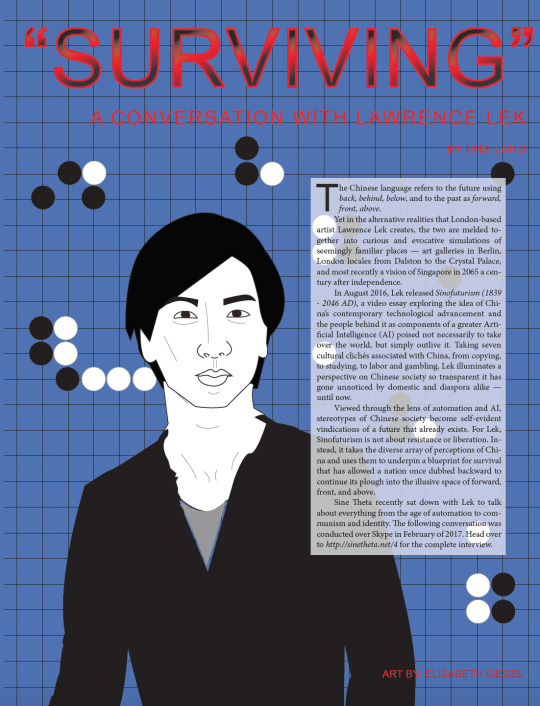
Artwork by art director Elisabeth Siegel.
The Chinese language refers to the future using back, behind, below, and to the past as forward, front, above.
Yet in the alternative realities that London-based artist Lawrence Lek creates, the two are melded together into curious and evocative simulations of seemingly familiar places — art galleries in Berlin, London locales from Dalston to the Crystal Palace, and most recently a vision of Singapore in 2065 a century after independence.
In August 2016, Lek released Sinofuturism (1839 - 2046 AD), a video essay exploring the idea of China’s contemporary technological advancement and the people behind it as components of a greater Artificial Intelligence (AI) poised not necessarily to take over the world, but simply outlive it. Taking seven cultural cliches associated with China, from copying, to studying, to labor and gambling, Lek illuminates a perspective on Chinese society so transparent it has gone unnoticed by domestic and diaspora alike — until now.
Viewed through the lens of automation and AI, stereotypes of Chinese society become self-evident vindications of a future that already exists. For Lek, Sinofuturism is not about resistance or liberation. Instead, it takes the diverse array of perceptions of China and uses them to underpin a blueprint for survival that has allowed a nation once dubbed backward to continue its plough into the illusive space of forward, front, and above.
Sine Theta recently sat down with Lek (@lawrencelek) to talk about everything from the age of automation to media and identity. The following conversation was conducted over Skype in February of 2017.
IRIS LANG: In Sinofuturism, you talk about wholly embracing these clichés of Chinese society as a means of subverting cultural stereotypes. As someone who is Malaysian-Chinese and born in Germany, educated in the UK, how did you become aware of these stereotypes and how did they affect your perceptions of China and your own ethnic identity growing up?
LAWRENCE LEK: For me, Chinese society, because of its focus on the family, is something that assimilates into a culture in very different ways. Of course, every culture does that differently. I think what’s interesting is that –– obviously things like African diaspora or Chinese diaspora happen in many different ways –– but for example, I also do feel there’s a reason why, let’s say, a very big feature of overseas Chinese populations is Chinatowns across the world. You might have Japantowns or Koreatowns but generally Chinatown is the dominant one. And I think it’s to do with not just language barriers but also a different kind of family, clan, insular, isolated mentality that earlier generations of Chinese immigrants had, whether it’s in Southeast Asia like in Malaysia, Singapore, Thailand, etc. versus in the West like in the UK.
And of course, another thing that’s quite different is that the nature of Chinese immigration to America via New York or California is really different to the nature of Chinese immigration to Southeast Asia, and many of these came along at different points of history. In America, it had more to do with 19th century American history, whereas in Southeast Asia it had much more to do with British colonial expansion. My parents, for example, are Malaysian-Chinese but they moved to Singapore like many people of their generation did because it’s majority Chinese –– more opportunities and so on. Even within that specific post-colonial context, in Southeast Asia. I was born in Germany but I grew up until I was ten in Hong Kong, Bangkok, and Singapore, so I always thought about what makes me different to, you know, people who just live in Kowloon going about their life. Why am I able to have what we would now call this kind of ‘millennial’ experience? And it’s a lot to do with the growth of globalised and neoliberal society, as well as economic development of Singapore and Hong Kong, and the opening of China, all of these things. It’s all tied together.
But it’s very rare to see an artistic representation of that. For example, you have 1980s Hong Kong films, whether it’s heroic bloodshed type stuff, or martial arts films. It’s the most one-dimensional view of Chinese development. I wasn’t thinking about it consciously at the time, but there’s so many, for example, huge amounts of references to Opium War stuff in Jet Li films, which is an incredibly pro-China, nationalistic type thing, and they’re all set in Shanghai in some kind of Chinese exclusion zone such as Bruce Lee’s Fist of Fury, which was based around that kind of setting. So there’s this idea of Chinese repression, as well as Western domination from this more Chinese chauvinism point of view. This idea of Chinese nationalism is really strong today as well. But at the same time, in Singapore and Malaysia, in the kind of English-speaking, postcolonial Chinese societies, there’s not as great of a problem about it, because Southeast Asian countries have benefitted more and they never had this trauma of the Hong Kong handover, or any of this stuff to deal with. They were kind of far away enough to be independent, yet close enough to still be tied geographically to the mainland and have that relationship.
So anyway, I’ve always been super conscious about all of these different ways of framing the debate about China and Chineseness, and also because of Singapore’s idea of being a multicultural, global nation that happens to be majority Chinese, it’s often been said that it’s kind of an ideal Confucian utopia because it’s really paternalistic, really hierarchical, the government has so much power and authority — but you can’t argue with it, so the argument goes because it’s been quite prosperous. And of course there’s problems of civil liberties, but that is complex.
IL: While we’re on the topic of the Chinese empire, what relationship does Sinofuturism have to the history of the Chinese empire? I noticed with the date in the full title, Sinofuturism (1839 - 2046 AD), you began it with 1839 which is of course the First Opium War, so I was wondering what your decision making process was in choosing these dates. What does Sinofuturism have to do with the so-called ‘century of humiliation’ that China went through?
LL: So just taking those two dates, 1839 and 2046, completely ignoring the seminal events in Chinese history that may or may not have happened, looking at it through a kind of global perspective, you’re going through the Industrial Revolution, into the so-called 4th Industrial Revolution with automation and AI. This gives you a two-hundred year period that is more or less the bulk of industrialization and so-called modernity in the world, and urbanisation, changing from agricultural societies to industrial ones to post-industrial ones and so on. I think that timeline, which starts in the past but goes forward into the future, is something I’m particularly interested in. It can start with the Opium War, and it can end with this kind of film that people may or may not know it’s a reference to.
IL: The Wong Kar-wai film, right?
LL: Yeah, exactly. But with this idea of Sinofuturism –– previously, I haven’t been particularly interested in making any kind of overt statement about geopolitics or whatever. For me, it should be embedded in the work, and biographically I don’t think it should be a main point of an artist’s work to talk about themselves, unless they really want to for whatever reason, which is fine. I just particularly don’t. But for me, as you know, in the past 12 months my impressions of the UK where I’ve been living for what, 20 years now, have actually changed quite a lot, and made me realize that post-colonial countries have a strange relationship with their former ‘motherland’ or whatever. You see this with America and Britain, or Congo and Belgium, or Singapore and the UK, so it’s not so straightforward. The reason why I stayed in the UK is because I believed, and I still do, that it’s generally a liberal and quite free place. But things like the Brexit vote, which I understand for the same reasons that I don’t think the result...here’s the thing, the crazy thing is that I think if you had a similar referendum in America or in China or in Singapore, the result would pretty much be the same. They would be like, “We wanna be independent” and so on. So I think it’s a stupid thing to ask the people, because they’re easily swayed. But at the same time, I don’t think there’s anything inherently ‘bad’ about Britain, or anything inherently racist or xenophobic about it. I think fundamentally, British people do believe in a kind of fairness.
But anyway, things like this, Brexit vote, etc. –– this kind of cascade of events did make me think that actually, for me, Sinofuturism is not about a pro-China dialogue. The thing is, I had so rarely seen interesting discourse about China and futurism from anything other than a really abstract cinematic perspective. The kind of CNN perspective as well. And also, the fact that China, for some reason –– and I still wonder why this is the case –– Chinese culture and its relationship with technology or science fiction is very strange. For example, science fiction now of course is growing more, but it didn’t really have a place in Chinese cultural literature, and I feel that basically magic and fantasy take the place of science fiction in Chinese culture. You have lots of shenmo (神魔), gods and monsters kind of stories, and all the super martial arts experts who have superhuman powers but they’re not technologically enabled.
Basically, there’s no equivalent of the Marvel Comics Iron Man kind of character, who uses machines to achieve great ends. I always feel that even in Chinese movies, it’s never about machines, it’s always about loads of people really working hard to accomplish something. That has nothing to do with technology, and it really has a lot to do with work ethic and working together and all of these good moral virtues. Or like, if you want to beat that guy, you just have to train for like 5 years on a mountain or whatever, but there’s nothing technologically driven, you’re just punching the tree for 5 years and then you get really good at punching the tree. It’s kind of really dumb. The faith in technology is more to do with magic or knowledge, or supernatural things, or the knowledge of your special five-point heart exploding palm technique, that kind of thing — as opposed to actual technology.
Of course that’s changing now I feel, because there’s more interest in science and computers in Chinese society. Engineering is the thing now, and with the more technocratic society, it’s all slowly changing. But all I’m saying is, it took a long time to get to China, for whatever reason –– maybe Cultural Revolution ideas to do with science and progress, and also maybe I’m guessing in the 60s, 70s, 80s, a lot of Chinese technology was very much to do with heavy industry, and they had a lot of their knowledge in partnership with the Soviet Union and that Communist bloc, as opposed to the kind of open science idea of the West. But science and technology, and science fiction are closely linked to portrayals of science in popular media. For example in America, the space race was obviously closely allied with the intercontinental ballistic missile program, but of course it was the PR –– the space program is PR for military stuff. Or in the SU, where the space race was tied in with military development. But I think since forever, China has had way more civil war problems than anywhere else, so it tends to stay more insular.
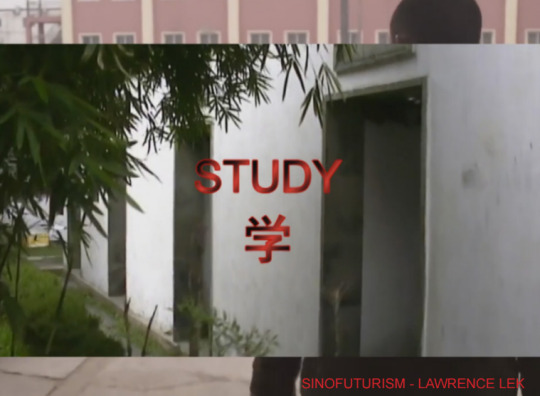
IL: I guess you kind of answered it already, but why do you think China took so long to embrace technology and sci-fi –– do you think part of it stems from how China views technology as being associated with ‘the West’ and how so much of China’s cultural consciousness is built off of making itself different from the West?
LL: Totally, a lot of it has to do with the general refusal to learn from anything apart from a certain section of history, for example. Let me put it to you this way: I might be wrong, but in Europe at least, the Enlightenment kind of revolutions and political theory and philosophy and culture and science all happened in parallel with a destabilisation of religion as the central force in peoples’ lives. For example, if Christianity and the church still stayed the dominant force, of course science would never go anywhere.
But I think the history of Chinese insularity is very, very old, and this is very broad history –– I don’t know how accurate this is –– but it does seem there is a refusal to learn from not even just the West, but even from the Middle East and other places. I feel that because China never had religion as the guiding force of peoples’ life, they never had really doctrine-heavy “Thou shalt not xyz” because that was just Confucianism, which was tied into politics and management of society. They didn’t really have this parallel integration of church and state, like there was in, what, the whole of Europe or the Middle East. It’s much more about management and military, hard power like that, rather than the soft power of religion which is about social control in a different way.
I mean, the belief of Confucian societies is “if it’s not broke, don’t fix it”, right? So if it’s not broke, what do you need technology for? And it’s also this kind of classic thing where, from what I understand, with many of the Chinese inventions they were like “We invented the compass and all this crap”, but what did you do with it? You didn’t go anywhere, it’s just for fengshui and stuff like that, right? It’s not to cross the ocean and pillage a whole continent. I feel also the whole attitude of newness and innovation is very different –– the attitude towards the individual over the welfare of the collective, the attitude of innovation as opposed to continuation of history, all of these things are, again, cultural stereotypes, but really very strong I feel.
And even in the case of, let’s say typical Chinese stuff like the dynasties –– no matter what dynasty took over, they would all implement the same system essentially. The Manchu emperors would take on some Chinese name, they would basically conform to the historical system as opposed to establishing a really revolutionary one, which is again probably more to do with good management than innovation. And then of course, there’s the question again of whether the Western Enlightenment was good in terms of what we call social freedom and social welfare, and whether you can implement that in tribal societies like in some parts of the Middle East without huge problems. It’s not the perfect solution.
The problem is, with China, that the scale of implementation and also the levels of development. Places like Singapore or America were basically inventions that came at a very specific time in history, to some peoples’ benefit and to some peoples’ suffering. And on a personal level, I just have this feeling, and I’m sure you do as well, that sometimes reporting on China is annoying. Even on the simplest level, in some of the news clips I use in Sinofuturism, all the time it’s just stuff like “China is making guns.” “American can’t make bullets.” There’s this phrase that this news commentator used, “China’s not just exporting metal, they’re exporting unemployment.” These kinds of ideas, which to a large extent are right and hugely accurate, but the interesting thing for me about Sinofuturism is that because China is such a huge part of the world’s industrial economy, just the shit that is made –– the desk, the pen I’m using, the computer –– it’s all part of it, so it’s not just about Chinese nationalism, it’s the furthest thing from that, it’s just about gaining a different understanding of how the world is made culturally and historically.
Because also, having grown up here [in the UK], I just assume everyone understands the same things, or the same geopolitics as I do. And of course just because I’ve grown up in a different place, all these things I’ve grown up with –– addiction to gambling, studying hard –– it’s hard to see them as something other than… what your aunt does, do you know what I mean? To see them as something that actually reveals some kind of deeper truth. People love gambling because they work really hard, and it makes complete sense, right? And psychologically speaking, the desire to have these really strict hierarchies and structures — basically, Daoism and Confucianism go hand in hand, because one is about absolute personal freedom, and the other one is about absolute obedience and subservience to a notion of control. So I find that these two contrasting things are kind of like Satanism and Christianity, they almost go hand in hand perfectly.
But anyway, in the last year with personal Brexit stuff and my reaction to that, I was kind of disappointed after talking with some people that Sinofuturism as a thing just didn’t exist. It did in bits and pieces, obviously there’s lots of articles talking –– especially in American press –– about whitewashing The Last Airbender or The Ghost in the Shell, but that’s not interesting to me, because they’ve done that with black culture for the last hundred years, and they’ll do it with Bollywood, they’ll do it with anime, whatever, who cares? That’s important from a kind of racial activism point of view, but for me, I don’t fully identify with either side so it’s just not personally true if I said I’m against xyz. I think it’s interesting to be mixed and to think about the kind of possibilities of that.
IL: In many of your works, such as Unreal Estate, Europa Mon Amour (2016 Brexit Edition), and Shiva’s Way, you make use of multiple languages in both audio and text. What role does language play in your art?
LL: First of all, it came out just by using a lot of different collage sounds and sources. I’d extract clips from films I like, those of Wong Kar-wai and Tarkovsky, that all talk about, in very basic terms, the disembodied experience of traveling and people on a journey - e.g. in films like 2046 or Stalker. And in those languages, characters reflect on their psychological state while they’re in a different place or experiencing a different environment. For example, in Tarkovsky’s Stalker, there’s a Zone which is this other place that people go to realize their fantasies, which is quite a common trope, especially in science fiction: this idea of a wish-fulfillment fantasy that gets realized in another place. And similarly, in Wong Kar-wai’s films, the place of memory or recollection can be something as straightforward as a bedroom, or a futuristic train. It’s all about the link between memory and the future. So for me, language is used to suggest the idea of an internal monologue like the thoughts that you think to yourself, and not just dialogue that’s spoken between characters. There’s also dimensions where it’s more about the idea of what establishes a sense of place, because classically in cinema you’d have the setting, what city it’s set in, what language these things are spoken in, but I’m much more interested in the idea of disorientation and the place where you, as a viewer or player or audience or creator, are situated.
IL: What makes something a ‘place’ for you? From the way you describe it, it almost seems like using language as a way to explore one’s internal monologue can also paint that monologue as a place in itself, is that how you view it?
LL: Yeah, I mean there’s many different interpretations of the idea of ‘place’, and I think especially nowadays, the idea of ‘place’ –– let’s say, site-specificity, or any concept of a certain location that has to do with the identity of that particular place –– generally goes back to this idea of disempowering some kind of certainty in life. For example, political acts of ‘place’ had to do with nationalism, migration, immigration –– this very legal definition of borders that reinforce both the legal structure and social system of any particular country or city. There are a lot of formal borders in that kind of place, which of course we have to navigate in our daily lives. So there’s that very infrastructural notion of place. And then there’s a much more psychological and loose notion of place, where you’re sitting on the train but you’re thinking about somewhere else, which of course certain film directors do particularly well, especially when it’s about uncertainty and memory. So there’s that notion of place as well, which in cinematic or virtual world terms is much looser, because of course the audience is seeing the film, which is generally set in a different place, which may have been shot in a different place, to where it’s actually portrayed in a film studio and rendered on a computer or something like that. It’s multiple places nested in each other.
So there’s infrastructural ‘place’, then the representational space of portraying somewhere else, and also a more ‘fine art’ definition of the distinction between space and place, where space might be universal, and place that e.g. site-specific art or environmental architecture deals with more specifically –– the idea that every location on earth is different from the next one, either culturally, or topographically, or physically. I’m interested in all of these, and it’s quite a dynamic thing I guess.
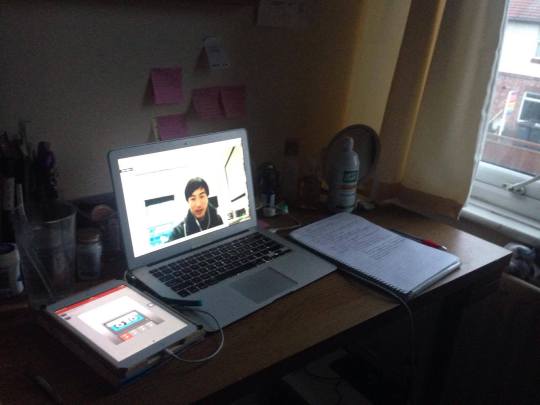
IL: What kind of relationship does Sinofuturism have with this burgeoning notion of techno-orientalism, of ‘the East’ as this huge technological and financial giant that will take over the world and how that view is another way of ‘othering’ East Asia? Do you think Sinofuturism in a way perpetuates this view, or does it subvert it?
LL: I mean, I don’t know. Let’s take the statement, “Chinese people are good at maths.” Because actually, in Singapore, I was not particularly good at maths, but when I came to London, I was a freaking maths genius, right? Why is that? It is unmistakeable to say that even though technology came late to Asia, they took it up so readily. Why is that? For example, what happened in Japan on the manufacturing side because of American investment after the Second World War, and investment in Korea after the Korean War. You could say a lot of it has to do with the multinational company influence that bleeds into local education and skillsets and visas to study overseas. The problem with any stereotype is there’s a lot of truth in it. I’m a Chinese guy making video games as art, what is nerdier than that? There’s definitely a true point in that, and whether I’m subverting or perpetuating these myths is not for me to say.
What’s important for me with Sinofuturism is simply that nothing about it existed before. What I’ve seen, in Asia as well, is this increased interest in learning about culture and the humanities, as opposed to sciences and professions over the years. And that means many more art institutions — I mean you get NYU in China, Yale in Singapore. And of course the academics who are a part of these institutions, with the best possible intentions, also can teach views of Asia –– they don’t want to, but what happens is they end up reflecting back Asia, to Asians, through the eyes of someone not from Asia. And of course, that’s always been the case. I mean, even if we go back to Orientalism in the 20th century –– that became hugely unfashionable of course, but if you look at early chinoiserie stuff in Paris or whatever, there really were these people who were just interested in Asia because it was different, and of course that became this ethnic othering, exoticism kind of thing and took on negative connotations. But at the end of the day it’s like, I like listening to music from Marley for example, because it’s interesting and a human made it and I like listening to it, what’s the bloody problem with that?
So on the first level of orientalizing, it is quite simply you are interested in a different culture, nothing wrong with that whatsoever. Then on the next level, which of course Americans especially are particularly militant about, is cultural appropriation. Like, don’t make chow mein because it’s not real Chinese food for example. I cook pasta and I’m not Italian, who cares? So what? But of course it’s more to do with the exploitation of minorities who might not see the benefit of what you’re doing, which I agree with. In principle though, there’s nothing wrong with appropriating cultures, because that’s what culture is. It moves and mixes around. But again I also feel that it gets more problematic when we talk about –– let’s be kind of left wing about it and say, ethnic minorities in the arts, or black actors who’ve won Oscars, this kind of conversation. One way of framing it is: there are no Chinese artists in American museums because of racial discrimination. Then there’s another way of framing it, there are no Chinese artists in American museums because their work is shit and derivative. There’s also another way, there’s just not very many [Chinese artists]. And I do kind of feel that it’s all kind of true and valid.
But anyway, I feel that what’s been nice is that Sinofuturism, for all its problematic hypotheses or whatever, a lot of people have been interested in it from many points of view. To a Western audience, it’s interesting from a philosophical point of view. But I think to a Chinese audience it’s actually quite genuine, because everything I’m saying there is true and it also rings bells of “Why hasn’t this been said before?”, which is kind of strange. But it’s also to do with a cultural stereotype, which is passivity and [is] very hugely dominant. Not just in the context of orientalizing, where a beautiful Chinese lady is passive or whatever, but it is also slightly true in the sense of “don’t stir up trouble.” So I think in the future, there will be even more scope for artists and writers with different points of view and I think that’s only a good thing. For example, a generation older, you have people of Chinese descent, let’s say, who have done interesting stuff that has been recognized in the West. But if I were to look at that interesting shit that has been recognized in the West — it’s so fucking limited, it’s unbelievably limited.
IL: There’s like, Ang Lee, and that’s it.
LL: Exactly! The problem is, when any culture has just a few stars in any field, they tend to dominate so hugely, which is completely a double-edged sword, right? I also think the role of like, Jackie Chan, and Bruce Lee for those a little younger than my parents’ generation –– people [would] just go up to you in the street and karate chop you. I guess this is the issue with not only representation in popular media and especially in America, it’s also to do with visibility and cultural visibility. The difference with like, the African American community is because their particular employment niche for stars is basically sports and music, so they’re highly visible. It creates this crazy contrast between the perception of the multi-billionaire Kanye Wests and the Boyz n the Hood kind of thing.
I think the difference for Asians is about visibility in the arts for doing something other than being like, a token actor in something, or something so niche. But America is a particular case of that, where I feel like I’ve never been identified as a ‘Chinese artist’, thank God probably, you know? Just as someone who makes stuff, sometimes in Chinese. But maybe it’s also to do with the generational thing, that if I was like 15 years older, I would definitely be a ‘Chinese artist,’ or an ‘artist of Chinese descent’ or whatever. Which I am but it’s never highlighted, because of course if you saw my work in those terms, it would be different. I guess it might also have to do with the more liberal culture of the UK or London. If you don’t want to identify yourself as xyz, it’s not forced on you—I imagine it would be quite different in the States, because of the notion of visibility. Visibility is about like, whitewashing of Asian stuff, or Jung Chang or Tiger Mom that kind of book. It’s so insane to me. Like are you fucking kidding that that’s the discussion, the model minority thing and all this shit, like it’s interesting but it’s nothing –– do you know what I mean?
IL: It’s very one-dimensional, like it’s all we ever talk about.
LL: Exactly. It’s kind of like –– I can even in the smallest way imagine how one-dimensional it is to be African-American, like Jesus Christ. It’s a really different situation.
IL: Why do you think this kind of discourse has a relatively smaller presence in the UK? Because if you compare the US and UK, they both market themselves as ‘multicultural’ nations with ‘diversity’ and so forth — why has this discourse around ethnic discrimination and representation risen so much in the US and not as much where you are?
LL: Well, I mean, again I think it’s super complex. But I think from my limited understanding, it seems that the history of ethnic discrimination in the USA hasn’t been solved. Far from it, especially today. But also its very foundation, basically –– you can’t really say this without sounding like a left-wing spokesperson –– but its very foundation is horrifically unfair, whether it’s for native populations or to do with slavery, which of course the UK is totally complicit in. It seems that America has always struggled with this idea of supremacy and kind of like, ethical innocence, and white guilt, and all these terms that are very specific to America. And of course, the more ethnic minorities or cultures become aware of it –– you know, classic Chinese Exclusion Act, Japanese internment camps, Native American reservations, all of these things –– it kind of all just feels insanely unfair.
I read this quite nice description by this British political writer called Will Hudson, and he framed it quite well. He said that the core belief of America is justice, in the sense that “okay, you shoot me, and I’m gonna shoot your kid, because that’s justice” and that’s kind of exactly what gun laws are based on. So the American core values are based on justice, and retribution, right? It’s very Biblical, eye for an eye. In the British system, the belief is less about justice and more about fairness –– this is kind of what he described it as. For example, you might say that the British belief is like, “You took this away from me, but I don’t need exactly the same thing from you, but we should compromise and find some kind of solution to it.” So it’s kind of more like soft power, which on one hand is highly manipulative and lets them control colonies not just by military force. The British way of control is not by military force but by wanting the elite of a foreign country to be British. So this is exactly what happened in India, Malaysia, Singapore — you just have English-speaking schools where the elite indigenous people go, and they grow up wanting to play golf and cricket or whatever, and then tada, you don’t even have to do anything –– it’s just the ultimate consolidating power.
Whereas the American system is like, fuckin’ throw them in jail or hang them. The difference is that the British evolved their notion of power from a force-based military, because it’s a small island, to a more manipulative but, you could say, fairer system. America just has much greater resources in comparison to do what it wants, unfortunately for some, especially nowadays. And it’s also interesting with these two things in mind, to question how China will exercise its power. Because a lot of it is to do with internal stability, which is obviously since Confucian times been the most important thing. Otherwise, literally millions of people die, so that’s fair enough.
IL: Going back to what you said earlier about this notion of passivity in Chinese culture, how do you think this notion of ‘victimhood’ as part of the modern day Chinese narrative figures in with Sinofuturism? Is Sinofuturism built off this narrative of Chinese people previously as victims?
LL: At the end of Sinofuturism, I kind of say that the thing about Sinofuturism is nothing to do with guilt or victimhood or being a manifesto. It’s to recognize that these aspects of Chinese culture are what allow this organism –– which we might call an AI or which we might call Sinofuturism –– to exist and persist and basically survive. I feel that the strongest motivation –– I’m generalizing here –– but the strongest motivation for Chinese culture/civilisation is not for it to prosper or stand out or achieve fulfillment in whatever. The main motivation is survival. It’s really as basic as that. Because I feel in places where survival is taken for granted, in tropical countries, survival is taken for granted because you’re hungry, there’s a mango, you eat it, you’re fine. I mean, I really do feel that that is a model for life. In the West, the idea of survival is taken for granted because of social safeguards, and quite sophisticated social welfare and things like that, even in America.
Whereas in China I feel it’s much more to do with survival, because life has been threatened so much more. I think that’s the main motivating factor. What’s interesting, if we think of the concept of “survival of the fittest”, is this kind of self-driven narrative. It’s survival of the fittest so you just have to kill the other monkey or whatever, and then you survive. Whereas the Chinese one it’s like, you can kind of run away and as long as you don’t stick your head out, you’ll also survive. So it’s another model. And both work, at the same time. But I think as this idea of Chinese passivity –– as people are exposed and just want to make a name for themselves, quite simply, this will definitely change. And I also feel it’s a generational thing, where it’s just part of millennial culture. Everybody wants to be an individual and be like a free-floating butterfly and that kind of thing. And there’s also [a sense of] “I want to escape from responsibility.” Every generation wants to have greater freedoms than they think their parents or grandparents had. I think that’s natural as well. And I’m not saying anything new but I think that’s also emphasized more with a kind of one-child generation, single child generation.
IL: Moving onto a different piece of your work, in Unreal Estate, you created an alternative version of the Royal Academy where its fate had fallen into the hands of a Chinese billionaire. Why specifically a Chinese billionaire, and do you envision China itself leading a ‘new world order’ in the future whether that’s technologically, economically, or politically?
LL: As a Londoner, since I’ve been here –– even in popular media, let’s say, 10-15 years ago –– there was this ‘rich foreigner’ who changed his identity. So people from the Middle East for example, rich Arabs with their ‘dirty oil money’ would come and buy whatever, and then it became like, dirty Russians. Roman Abramovich comes here and bloody buys Chelsea Football Club, and then people from the Emirates come and buy our football clubs. It’s kind of a play on that, and you see in the Evening Standard and whatever newspapers that Chinese come and buy all the penthouses in London, pushing up property prices, etc. So I thought, what’s a way to comment on that kind of social othering? But also, at the same time I thought as a relatively poor Chinese artist or person in London, there’s an element of critique to it obviously with that — the idea that everything, including art, is for sale. And at the same time, this idea of fantasy where it’s like, I would love to live there. Like, it would actually be awesome if that was your house, like wouldn’t that be crazy?
So there’s both this complete fantasy, like what I would genuinely want, and what would also be a bit of a nightmare for London as a whole. Also in the voiceover, which was taken from Tatler magazine and actually just translated into Mandarin — the things that are being said are kind of insane from a certain perspective. Like, “be careful when you hire your servant, have a butler,” that kind of stuff. But at the same time, they’re still incredibly genuine, because it is genuinely good advice from one billionaire to another if their friend just had bought this mansion. So that’s the crazy thing –– it’s both completely surreal, and completely genuine at the same time. I kind of like that combination.
IL: Going back to Sinofuturism, what place, if any, do ethnic minorities in China have in this narrative of Chinese people?
LL: There’s one point of view, where let’s say I made a video called US-futurism or whatever, and it was all focused on 25 Silicon Valley entrepreneurs and their assistants in California churning out pristine products. Then it would be problematic because it’d be like, “what about the American car industry, or what about the ethnic minorities who pick oranges for orange juice,” stuff like that. In terms of my model for the futurism part of Sinofuturism, the culture of China is to do with what I’m more familiar with, which is the South, and in particular coastal cities.
The crazy thing is that the kind of interface of China with the West is on the East side of China, simply because of the ports and Opium War blah blah blah, the maritime side. And it’s to do with the sides of China that have been industrialized because of this exchange, whereas to the best of my knowledge, the ethnic minorities in China have been those on the Northern borders, Mongolia, the Hui in Xinjiang, and those towards the Southwest in Guangxi and stuff like that, where they’re not just isolated geographically, but they’re also isolated industrially as well, because there is relatively little industrial –– and of course Tibet too –– because most of the industrialization, and I’m talking about the modernised industrialization as opposed to heavy industry which has kind of spread around, but the modern industrialization which is centered along the coast. I don’t know enough about how ethnic minorities in China are treated. I know they have special autonomous regions and there’s obviously a lot of problems that I’ve read to do with like, not whitewashing, but let’s say Han-washing Tibet, replacing populations. Of course that creates problems with Uyghur nationalists and stuff like that, but I don’t know enough about that to say much about it.
The Chinese situation maybe has more in common with Russia and its former Soviet countries that it likes bullying basically, and the many ethnic minorities that live within Russia as well. So the Chinese situation is more to do with how China has expanded over the centuries, kind of like Russia, taking over these places and then retreating, and then having bits of other countries inside themselves. It has more to do with the Russia thing than with America, because America is more to do with lots of people from different places or who were there first, who live in what’s now America.
But with China it’s more: the heart of China is this and then it expanded, and that’s where all the problems lie. Whereas America has grown to be a massive thing, and now it’s distributed in a different way. For example, obviously there’s the Dakota Pipeline, but there’s reservations all over America scattered around, but in the Chinese sense they kind of basically keep the minorities in the same place. I don’t know what the legal restrictions are to their movement, but I’m sure they’re not free to move anywhere they choose. But I think it’s definitely an interesting and different problem. What do you think, do you know more about it?
IL: I know as much as you do, but I just question whether China can continue exist as all these regions it encompasses, and I’ve read about how China has brutally invaded Tibet and the southern parts of China in the course of its empire, and nobody in China that I know of really talks about that. There’s this narrative of ‘peace’ and ‘the five principles of peaceful coexistence’ or whatever and it often feels like the Chinese government tries to brush a lot of its own imperialism under the rug.
LL: No totally, and how closely that imperialism just morphed into like, communist imperialism and so on. I might be wrong, but there was a Republican revolution yet I don’t imagine that much really changed. Because maybe it can’t — for example, let’s say in the UK there was a civil war and stuff like that, but it’s more of a gradual shift of power away from one side to another, it’s not like the French Revolution where it was a huge break with the past and they just killed everyone. It was more gradual transition and not as traumatic as in China or in Russia, and also maybe the scale of paranoia in early leaders wasn’t as bad [in the UK]. But I don’t know, like, I also imagine just an economic map China is very unequal, so I guess the desire for autonomy from certain places –– like Quebec in Canada, of course they want to be autonomous, they’re wealthy. Whereas with Xinjiang, it’s like, what are they going to do? Or like Scotland right, it’s wealthy now but really?
IL: Now that you’ve mentioned communism, do you see communism as fitting into Sinofuturism in any way? Do you think it’s another indicator of Sinofuturism? Because I’ve read a lot about how communism, like true communism, is sort of the ultimate end goal of this age of automation and AI and everything.
LL: There’s a lot of accelerationism which talks about emancipation from labor, basically. From what I understand, Engels-and-Marx-style communism is based on a kind of emancipation of the proletariat, from the terrible bourgeoisie. So the next stage is like, we can think of automation as the way to liberate humanity from the drudgery of work altogether, and live with a universal basic income, happy lives of tomato farming or whatever we so choose.
The really interesting thing is, say, if you were to ask what politics Futurism subscribes to. For example, if I were to say, “communism believes in the absolute equality of every individual and the eradication of property distinctions between them, irrespective of whether someone’s an absolute genius or just the laziest whatever in the world, totally divorced from actual active input.” So let’s say the politics is based on the principle that full equality is number one. The politics of Sinofuturism, if there was one, I think is much messier because it involves the belief that technology will liberate –– actually no, it won’t liberate you from anything –– Sinofuturism isn’t about liberation, it’s simply that your life will improve, and you will survive. So I don’t think it’s incompatible with capitalism or neoliberalism or late communism. It’s more of a cultural theory on how the very patterns which allow you to survive –– literally survive and eat and travel and so on –– should be seen not just as inherited traits or genetic stereotypes, but as something you can develop or challenge, whatever that means for you.
It’s also about taking things that are very culturally inherent and completely strong, and thinking about which of them are just inherited and no longer useful, for example your appendix or whatever –– like communism, right? Like many political theories, it’s beautiful in intention and in theory, but because it has to be executed by individuals, it’s hugely flawed –– because people are not all the same, they should have equal rights but not equal rewards. For example in terms of left-wingness in the UK, I find it really problematic as well. You see all of this Jeremy Corbyn Labour Party in disarray and it’s exactly the kind of case where they might have very strong values and they go down to coal mines and they cut trees down or whatever, but their work is just like everyone else’s. The paradox of human existence is that when people work really hard, you dream of like a free life where you’re just eating strawberries, but in reality when it happens it’s difficult.
IL: When you talk about embracing cultural stereotypes, or pushing them further, do you think doing that — as opposed to counteracting them — is a more effective means of deconstructing them or kind of diminishing their power?
LL: Let’s say with any phenomenon — okay wait let’s get philosophical here. Let’s say you have a thing. The Hegelian way of dealing with anything is you have a thesis, so let’s say “Chinese love gambling,” right? And artistically I’m going to make a film about Chinese people gambling. The antithesis is this kind of hubris thing, “Chinese people love gambling because they think they’re going to win the world but actually they lose everything and then they die.” And then the synthesis, which is like the finale where “They lose these things but they realize that life is actually more than gambling”, for example. So you could deal with this cultural stereotype of gambling by tackling it head-on. The most extreme example would be, I’m going to make an Adam Curtis-style documentary about the gambling problem in China, and I’m going to be straightforward about it. You might term that the most one-dimensional embrace of that way of thinking.
Or you could think like, how can I get away from that? What’s the farthest I can get away from that? So you might make a work about like, working really hard at doing something and taking no element of chance left aside. You know the Tehching Hsieh Time Clock thing? He’s a Taiwanese performance artist who did this performance where every hour, he punched a clock. It’s an amazing performance, but that’s basically the epitome of a [Sino] person working insanely hard at doing something all the time. It’s kind of like a work that has no element of chance in it, no element of fate or gambling. On one hand, you can do the most random playful thing, let’s say not even a film about gambling, but that I got a £10,000 grant and I’m going to spend all of it at the casino. On the other hand, I’m going to do this performance piece where I am literally working so hard for one year and proving it. They’re not a million miles away from each other, if that makes sense. And I think with a lot of these cultural patterns, not even stereotypes, like gamble, work hard, they actually go perfectly together.
For example, the idea of studying and working –– they’re kind of like total opposites at the same time, right? The more you work, the better you can do your particular job. The more you study, the more you can change the nature of the job that you do. So the paradox is, you can study what you’re working –– so like, “I’m a Chinese brush painter and I’m going to study the old masters” –– and you can also work really hard at studying. So they’re all very closely related and linked together. And I think depending on your own personality, people tend to prefer following patterns in order to gain their freedom, and some people like leaving all that stuff to one side, and then reintegrating into the society. Either they burn their bridges first and then they find their own way, or they find their own freedom through particular systems, and both work.
Maybe another thing that’s interesting with this post-automation communist thing is the notion that you can’t escape because the world is changing, and the climate is changing, for the worse probably, the nature of automation and artificial intelligence is also going to totally revolutionize both human knowledge-based work and service sector work as well as mechanical work. So the question is, what are you going to do? Not in this conspiracy theory way, but in a really tangible way. Can everyone really be a creative worker and write things for a living, is that feasible? Maybe it is.
But from a cultural perspective, these things are certainly happening. From an artistic perspective what’s interesting is when these things do happen, are we just going to replicate the same kind of work, or the same kind of thinking that people have done before us? Because for our generation, we’ve learnt more and communicated more. I probably have more tertiary education than the last 6 generations of my actual family, which is insane right? But knowing this, what is possible?
Let’s say for someone who has dedicated their life to studying or being involved in arts and culture –– there’s one way of saying it, where the kind of self-doubt involved can be: “Why am I not being a dentist and being of use to society”, right? “Why don’t I have a real job?” That kind of question, which is very valid. “Is what you’re doing of use?” Then there’s another way of thinking: Of course what I’m doing is of use, because culture will only be of more importance in the years to come, and that will give us our sense of self-worth or whatever.
And then there’s also the notion that probably your great-great-great-great grandparents would think it’s quite cool if you’re like studying in the UK and you have freedom. It’s also this notion of time, which is very different and of course it’s a very traditional ancestral thing to think about –– your family but also the people who came before you. But I feel that it’s like how religion gave way to science –– when that happened, individuals and society lost a lot of psychological support networks that they used have like the promise of an afterlife and all this shit about how heaven is great.
IL: That cushion.
LL: Yeah exactly, that cushion right? In the same way I also feel that modernity and industrialisation and blah blah blah in China will also have big repercussions on those psychological safety nets that I guess Chinese culture has depended on for so long. The family in many ways provides psychological support for the individual in Chinese culture. So as that gets eroded, or changes because of smaller families and technological changes, I think there’s a different set of things that Chinese artists will respond to subconsciously. But the way in which that will turn out, nobody knows yet.
37 notes
·
View notes
Text
Music Review: Dasychira - Immolated
Dasychira Immolated [Blueberry; 2017] Rating: 4/5 In a 2015 lecture to the European Graduate School’s Media and Communication Studies department, Benjamin Bratton, an American theorist, sociologist and professor of visual arts, presented thoughts dubiously compiled under the frame of “The Post-Anthropocene.” His talk began with a description of the now non-existent “Sanzhi UFO Pod City,” a seemingly futuristic city built in 1978 near New Taipei City in Taiwan for vacationing US soldiers. The city was abandoned in 1980 due to a series of suicides and bad omens believed to be the result of evil spirits enraged by the destruction of an ancient dragon statue. As ruins tend to, the grounds became a home for a range of non-human beings. 10 million orchid mantises from five different species developed an intricate civilization enmeshed within the human-made structures, co-composing a living architecture with several species and sub-species of orchids. The ruins, insects, and plants together formed an inter-special super-identity, reminding us, according to Bratton — that “The Future city is not for humans.” He furthers that “The Anthropocene, the reframing of the Earth in the image of industrial modernity, will be short lived. It will be less of a geologic era than a geopolitical instant. Humans are vanishing. Our cities are not our own. We are building the habitats for life forms other than our own. We are their tools, we are the robots for future insects…” Within this frame, the machinic music being developed by and supposedly for humans by human digital composers — the signifying sonics of spliced vocal components, spectral AI effects, high-impact digital ephemera, agile rhythms — all can be seen as wholly impermanent extensions of personal will haphazardly located in abstract communicative environments. The recordings placed here are willed into being. They flash, and then disappear; they become archived to hard drives as impermanent as sand huts in the desert, quick to be blown away back into a shapeless form — sound into sonority, back into an insectoid buzz. As mentioned in a review of M.E.S.H.’s Piteous Gate, there is an expansive, loose association of international producers who know full well the allure of Machinic Eros, as Felix Guattari calls it, “the desire to be in the thick of things,” be it culture, technology, symbols — the whole range of messy systems humans attempt to wrangle. These artists often use a cinematic symbology and all of its tropic tendencies to arrive at a statement of personal vision, interpolating trending audio into prodigious wills to power, wills to become, or, in the case of South African producer Dasychira, the will to un-become in an audible act that reflexively acknowledges a fragile humanity at the center of this discourse’s high-fidelity. Bratton would refer to this pantheon of sound loosely as a “disintegrated communicative array, an atmospheric metropolis built of digit-strings, where the addressability of physical objects (withdrawn into their specific enumeration) is itself overmatched by the addressability of abstract relations between objects, placing them toward substantialized abstractions, towards an absolute communication and absolute in-communication simultaneously.” Whew. Immolated, Dasychira’s debut release on Blueberry Records, follows releases by label head FaltyDL and the massive debut of Elysia Crampton’s acclaimed American Drift. The EP shines as a statement in the overflowing field of abstracted “club-ish” music; it doesn’t seem interested in a will to power, escapism, or even the apparent Kafka-narrative of the culinary human materializing as insect. Rather, he demonstrates a cannibalized un-becoming, an immolation of the human into sound-structures like the insectoid co-composititon of Bratton’s human-mantis-orchid-ruin superstructure. Dasychira’s overwrought, emotionally detailed, yet somehow still near-empty productions contain the full ornamentation of high-fidelity club music with a deconstructive agenda. The EP’s tracks are armed with sounds and tactics normalized within the field. They brim with affective potential — “heart” music appealing to the whole scope of human desire. Yet, still, these tracks acknowledge this human desire fading away — arriving as fleeting apparitions, club songs for no one — soundtracking movement between spaces, interstitial states, species changes. “Reliquary” and “Deviance” underscore the EP with a semi-melodic, infrastructural ambience obscured by hostile, chattering interruptions. These pieces veer into sweet affective nothings, Zazen poems delivered off the cuff of a prayer hand. They lament for human impermanence, displaying a nostalgic pathos toward a momentary cinematic understanding lost forever. Nodding at Arca in general timbre, Immolated’s substance is more deeply defined by a pining tone that comes to full fruition on the closing track’s outro, where percussion and melody are both tuned into a wriggling, sharpened moan. These somber moments shift into concise focus on “Caduceus,” an obvious single that easily outruns similarly-minded 2017 club attempts. The track is fueled by a molten emotional core that, again, balances a powerful initial presence with melancholy, as the piece moves into a wistful dissection of the track’s infrastructural characteristics. It cannot be overstated how ubiquitous attempts at manipulating and stabilizing human affect have become in 2017 electronica. Relentlessly, productions veer into massified attempts at cinematically swallowing whole experiences of apocalypse, dysmorphia, and alienation into highly coded extensions of personal will. Dasychira’s music skirts through this milieu with a truly thoughtful impermanence. Human artifices are rusted, damaged, torn, and co-composed into a sonorous, non-existent “Sanzhi UFO Pod City,” an architecture quite different from the futuristic designs of IDM and deconstructed club music that the EP floats through. Kyselina, the machinist 3D artist responsible for the EP’s cover art, has designed one of his most compelling works for this release, a spectacular example of a human hand composing the utter living character of a mantis larvae incubating under laboratory conditions. As the complete visual frames the record, the sheer detail here matches and then surpasses the music’s sonorous detail. It’s a vivid acknowledgement of our transience seeing the virtuality of this living creation become real again, brought forth by a human will from the void through digital ephemera — extending into sound — highly complex and ornate sound that touches all of our excitations and hysteria, then descending back into either a cosmic silence or the deafening buzzing of insects, droning without form forever. http://j.mp/2m8p5wP
1 note
·
View note
Text
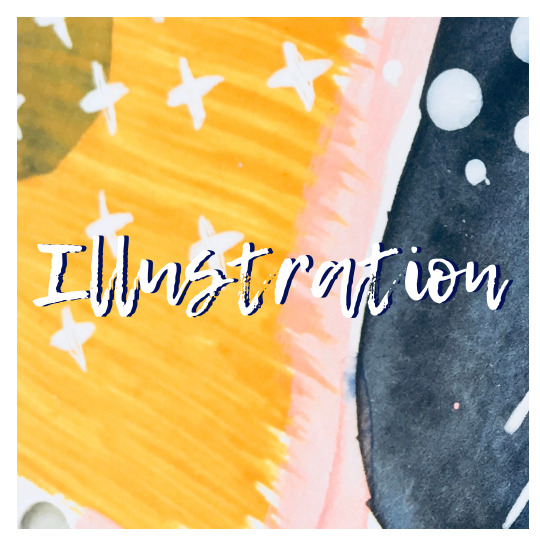
Low Poly
Illustrator can be used to produce vector drawings and high quality images in a number of different styles. Vectors are equation based images, meaning no matter the size of the original illustrator document, it can be increased to any size and still not lose quality. Bitmap, on the other hand, is a pixel based image, which means as the size is increased, quality is lost. Low poly is an illustration style that uses geometric shapes (triangles) to create form and structure. There are other methods of producing illustrations using illustrator:
Simple Gradients - using a simple gradient to produce contrasting lines and forms in a subtle way.
Use of Line - using muted greys and a bright coloured contrast creates a bold stylised design.
Simple Shading - using a darker coloured shape over a lighter coloured shape produces highlights and shadows.
Some things to remember when using Illustrator are:
The file has to be exported to a PDF rather than a JPG file to retain the vector quality of your illustration.
.AI is the native Illustrator file, the same as .PSD is the native Photoshop file.
Artists who are well known for using low-poly include Breno Bitencourt and many others:
Eran Hilleli - Hilleli is an animator who produces his experimental character design animations in Unity (a real-time game engine platform, used to create half of the world's games), using a particular framework (Keijiro Takahashi’s Klak framework) especially for creative coding. This is a much more advanced method of producing a low poly character, but shows the versatility of this technique and how far it can come. The second piece below is an experiment in which you control the movement of a character through a midi device normally used for audio work. I love the colour palette and use of texture in Hilleli’s work as he consistently uses teals and greens, which makes his work distinctive, especially the way his animations move; due to using the midi device already explained.
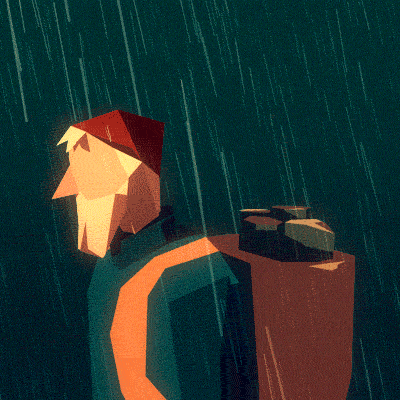
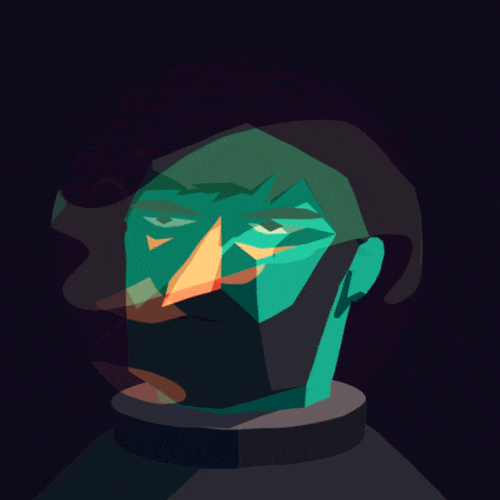
Timothy J Reynolds - Reynolds is a 3D illustrator who creates abstract minimalistic pieces yet are beautifully detailed. As already noticed with Hilleli’s work, Reynolds’ work also has a theme and repeating colour scheme of warm, earthy tones, which gives his work a nostalgic feel and soft yet detailed aura which I love and makes his pieces unique.
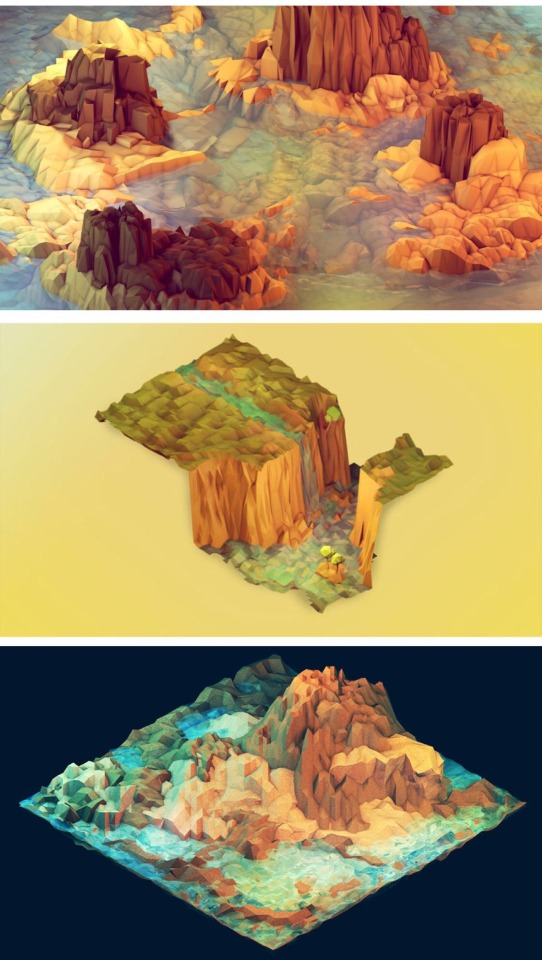
Jona Dinges - Dinges is another low poly illustrator who produces both animals and characters in varying colour palettes and settings. I think Dinges is my favourite of the three illustrators researched as her character design work is so detailed and full of emotion and character. Shading and use of coloured lighting on her characters is also very prominent in her work, which makes it very distinctive and bold and full of detail whilst being very minimalistic due to the low poly style.
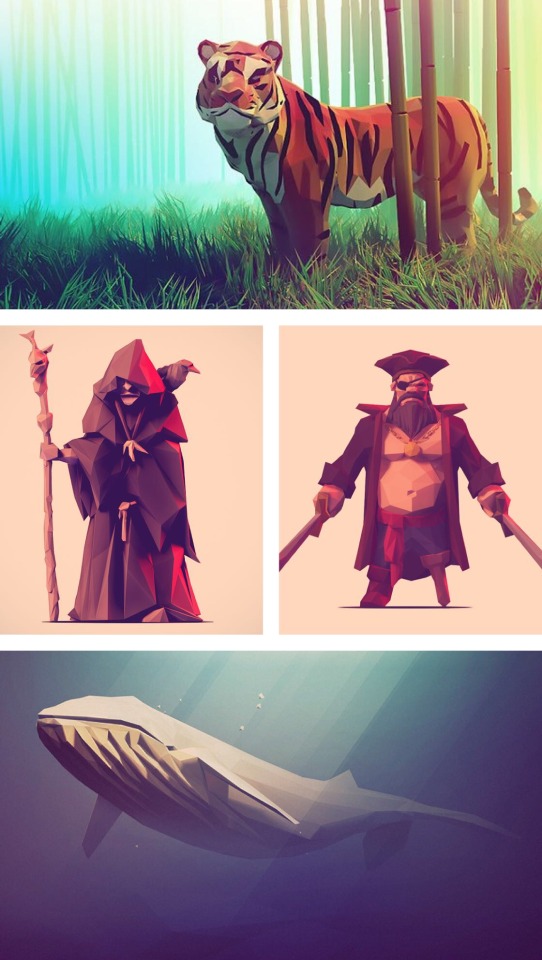
To produce my own low-poly piece, we were given a tutorial and a handout full of instructions and troubleshooting option, then opened Illustrator and began. I chose to produce a portrait as oppose to an animal/landscape, but I think in future I would like to draw a 2D character and illustrate it in low poly, making it 3D.
I used the eyedropper tool to choose the colour from the image below, then the pen tool to produce the triangle of this colour. I continued to do this for the entire image, producing a 3D illustrated outcome. Below is my first attempt at low-poly. I was very pleased with this outcome due to the heavy shadows which I felt were very effective, especially when matched with the vignette background to convey the lighting.
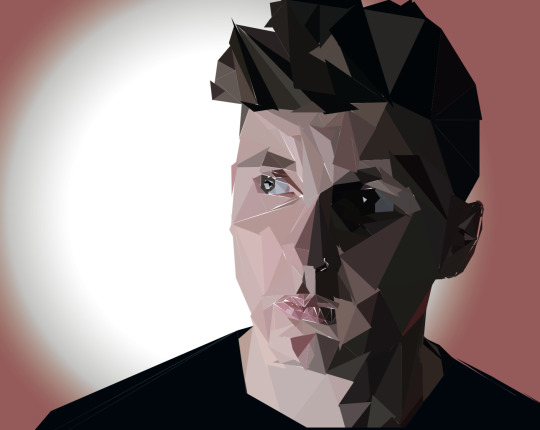
I did, however, realise that there was too many sections of the white background visible, which meant I then went back into the Illustrator file and moved some triangles in the left cheek and eye areas to be closer together, removing the white sections and giving a much fuller 3D face structure. I was much more pleased with this as I now felt with the eyes more refined the overall low-poly illustration was much more effective.
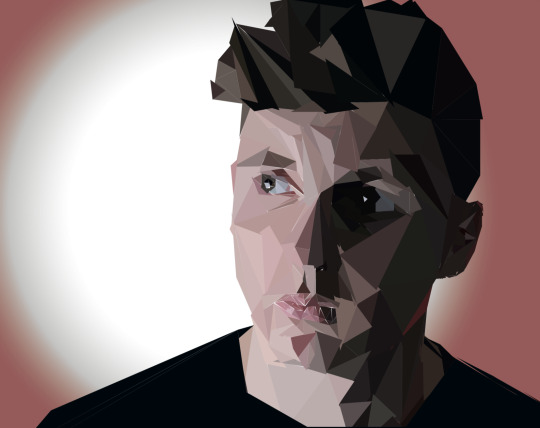
Now, I noticed the white areas of the lips much more clearer and returned to the file in illustrator for a final attempt. Here, I fixed this by moving the triangles using the ‘V’ shortcut on the keyboard. The final completed low-poly piece can be seen below, which I am very pleased with and feel it is very effective in producing a 3D stylised illustration.
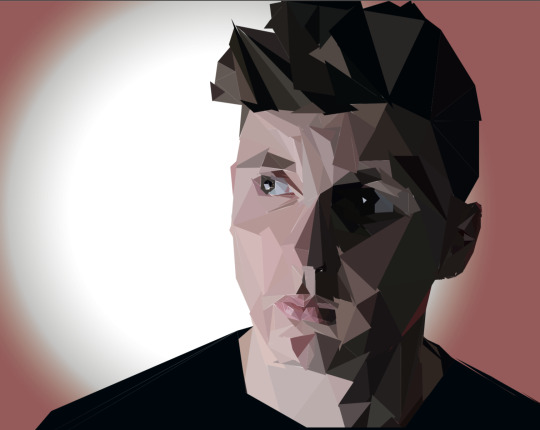
If I were to revisit low-poly, or had more time to do this, I would go back in and remove some very large triangles to replace then with many, much smaller triangles, which would completely refine the piece and make it much more effective and detailed.
I did just that, reproducing an image of a mountain in low-poly. I was much happier with this outcome but although it was much more detailed than the previous attempt I think some are probably still too large and I’m unsure whether overall it is very effective in producing a 3D outcome at all.
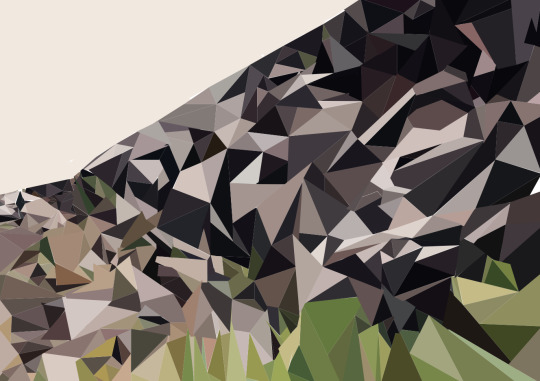
For this reason, I don’t think I would use this technique again, especially with the other options of illustrating we will cover later.
Typography
Graphic Design is a form of visual communication, using photography, typography and illustration; solving problems in fields such as branding, packaging, publishing, advertising, digital design, apps and websites. Typography, the focus of our second graphics workshop, is the technique of arranging type to make readable language appealing when displayed. There are many artists who use typography as the basis of their graphic design work:
Robert Montgomery - Montgomery is a conceptual artist and uses billboard poems, light pieces, fire poems, woodcuts and watercolours to ‘bring poetic voice to the discourse of text art’. I love the simplicity and modernity of Montgomery’s light and fire poems as I think they are bold and eye-catching whilst giving a somewhat nostalgic and warm aura to the viewer due to their locations. The poems appear to be somewhat sad, however, so bring a bittersweet, melancholy feel also. I haven’t got the resources to follow Montgomery’s style, however I could take placement and location into account, and would ensure that my typography is as bold and eye-catching as his.
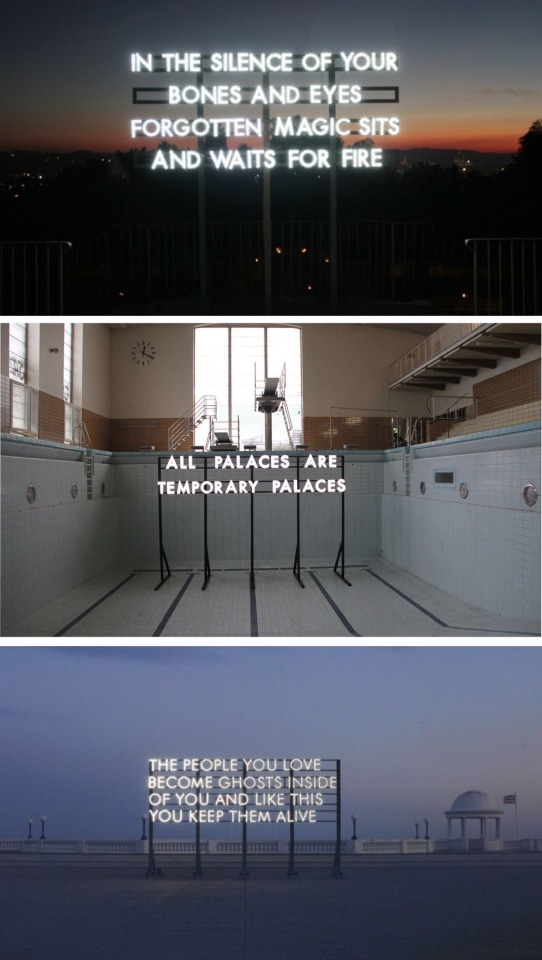
Tracey Emin - Emin uses her life events as inspiration for her works, revealing hopes and failures in both tragic and humorous ways. Her mediums range from painting, drawing, video and installation to photography, needlework and sculpture; but it is her needlework typographies that I am focussing on. Her use of juxtaposition - using degrading sentences and tragic phrases in a soft, comforting medium - is intriguing and somewhat humorous; which inspires me to explore using a comforting and familiar medium such as textiles to covey an uncomfortable message. In the development of my typography, I could use her as inspiration for the medium itself, or I could use the actual point of her work - using a comforting medium alongside tragic quotes to make them feel uncomfortable.
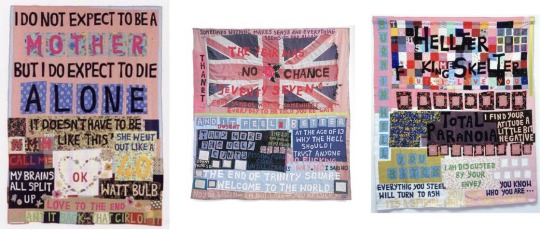
Antony Micaleff - Micallef is another contemporary artist, producing shocking and bold pieces using ‘political imagery fused with contemporary expressionism’. Micallef’s pieces are in a similar vein to Emin’s, using familiar, comforting, childlike imagery to draw the viewer’s attention, but upon closer inspection the words and phrases are tragic and completely juxtapose the imagery. His tragic words are bold and political, putting viewers into a state of discomfort. I think this is a theme that after picking up on in both Micaleff’s work and Emin’s as very effective, I would like to test and try in my own development of my typography piece.
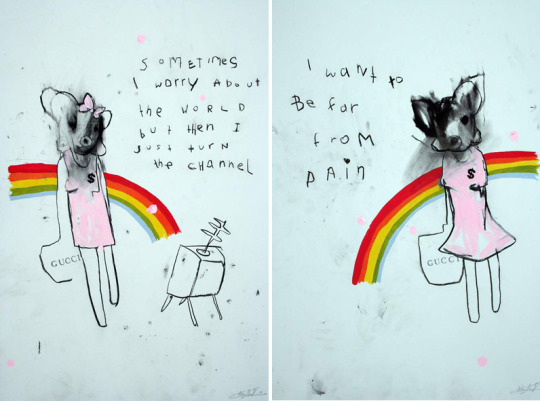
For my typography piece, I began by finding a quote, and settled with a shocking statistic - ‘The textile industry is responsible for 92 million tonnes of solid waste per year globally’; aiming to do something inspired by and Antony Micaleff’s strong uncomfortable statements in unusual places as well as Tracey Emin, as her use of words and textiles felt like something I would be able to replicate in my own way, especially due to this being my most enjoyable workshop so far. Upon searching through Pinterest for ideas, however, I came across Andy Smith, who’s piece ‘Words in the City’ inspired me to try to produce something more personal, perhaps including people or real buildings as oppose to just sewing writing into fabric. I then also came across Veronika Licakova’s pieces, where “visual magic” in the form of playful typography was added to the background of multiple Lenka Srsnova fashion editorials. The font and layout was soft and childish but worked as it didn’t take attention away from the clothes, especially as Srsnova is an extremely bold and graphical fashion designer, so they still remained the centrepiece.
Andy Smith - Smith’s work combines illustration and typography, producing almost humorous pieces full of energy and positivity but still all portraying the a friendly, handmade and hand lettered feel. I particularly love his pieces seen below, focussing on a real life setting with characters finding themselves surrounded by large pieces of lettering.
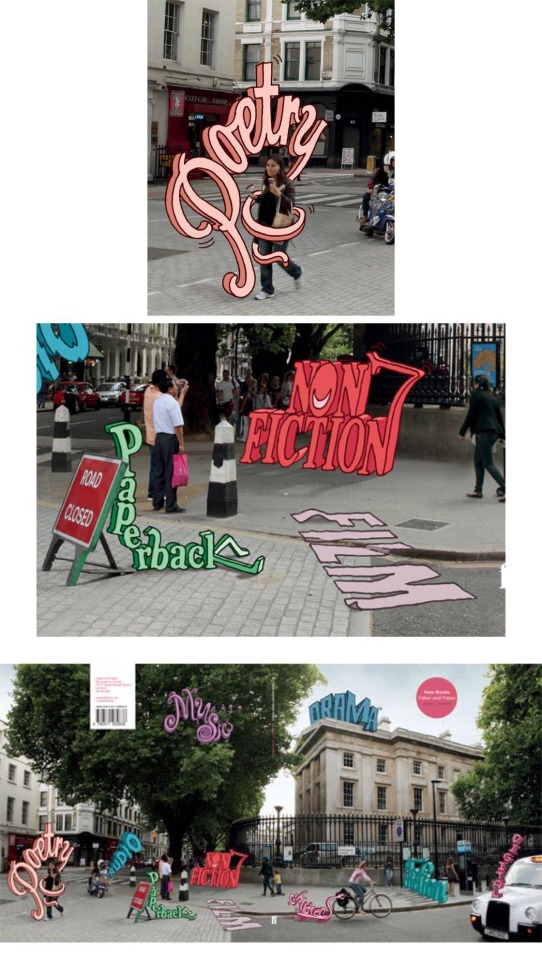
Veronika Licakova - I love Licakova’s playful, cute hand lettered typography as it compliments the extremely bold and brash outfits featured in the editorials, but in a subtle way. Whilst still slightly messy it has a soft element to it due to the matching colour palette for each editorial, as well as the matching words for each outfit, eg. ‘gold’ is used for the shoot directly below as the outfit is featuring golds and metallics, and ‘pink’ is used and so on. Overall I love the style of Licakova’s pieces and think they are very bold and eye-catching, whilst still allowing the garments and outfits to play centre stage.
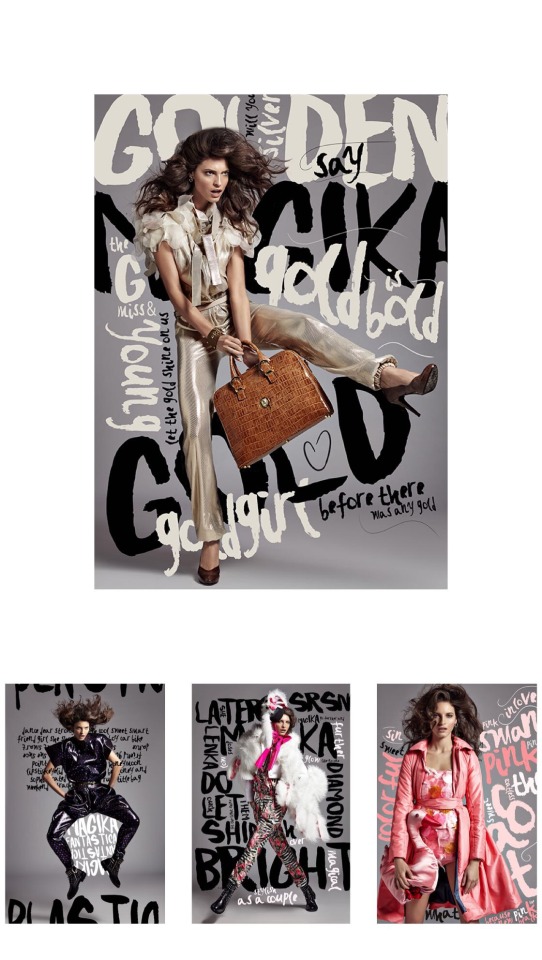
At this point, I knew I wanted to use a fashion editorial as the base of my typography, as this would allow me to build a strong contrast and juxtaposition between the point of the quote and the point of the editorial - the image is to sell the clothes to the reader, whilst the quote should make them guilty about wanting to do so. I was unsure whether I would be able to use someone else’s fashion editorial as the base of my typography, but came across a Ted Baker competition where his Instagram account posted a blank image of an editorial, followed by a note to the viewer to ‘doodle’ on the image however they want and repost it to be in with a chance of being featured by the account.
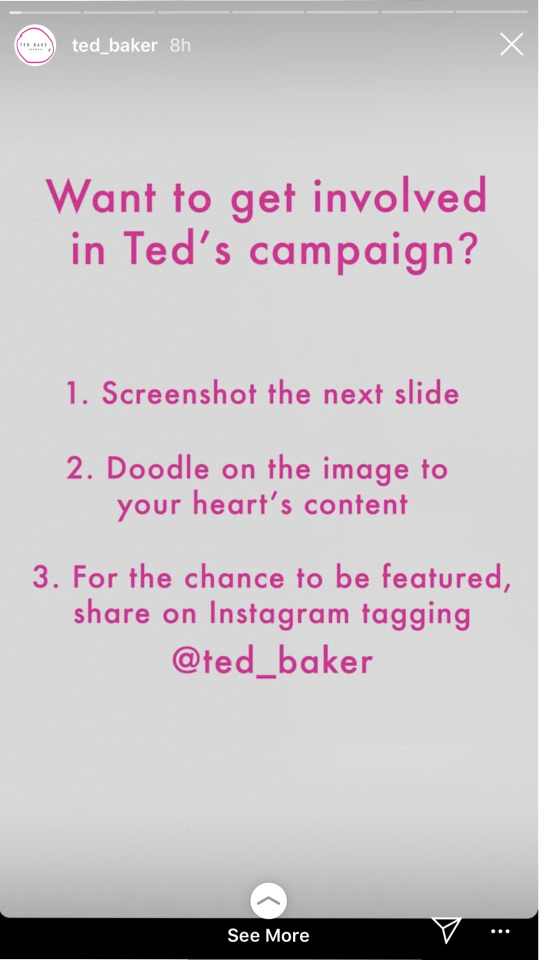
I took this to my advantage, and used this screenshot as the base of my typography as it meant not only would I be able to enter the competition, but I also therefore had permission to use the editorial to work on top of. I began by taking the image into Photoshop and playing around with my quote. I originally started by choosing an appropriately ‘scary’ font, and wanted to highlight the statistic by placing the shocking number on the front of the garment. I was obviously going to try harder to make it look like part of the coat itself, but decided I didn’t like this and felt that it took away the whole point of using the editorial in covering it up.
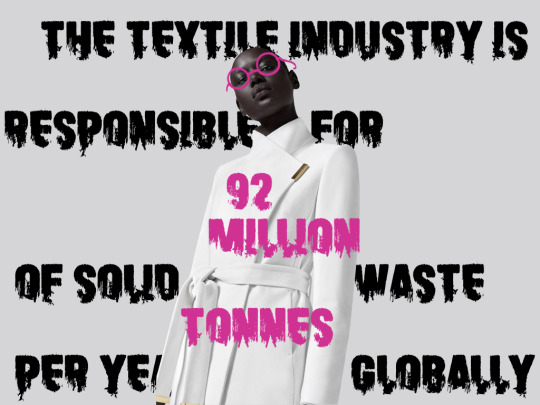
Here, I focussed on keeping the text in the background. I felt this was much more effective, but struggled to read some words and felt it looked too messy and simple.
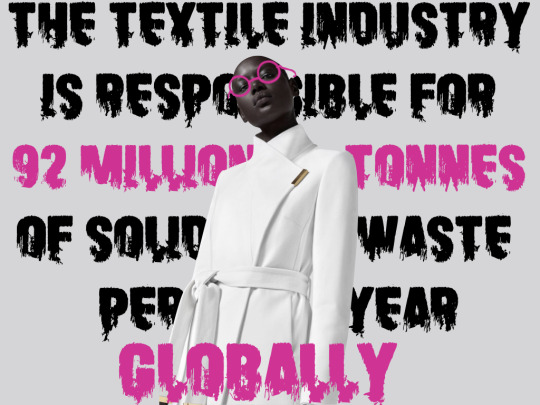
Next, I printed the editorial on A4, writing the quote multiple times all over the garment in ink as oppose to in the background. This felt far too messy and uncontrolled and was too hard to read for there to be any point to doing it this way.

At this point, I printed the editorial again, this time writing the statistic surrounding the model, in a similar style to Licakova’s editorial typography, but much simpler. I felt this was effective due to the use of the stark black ink and hand lettering, making it seem a lot more personal in comparison to using a ready made font which made it appear too rigid and staged.
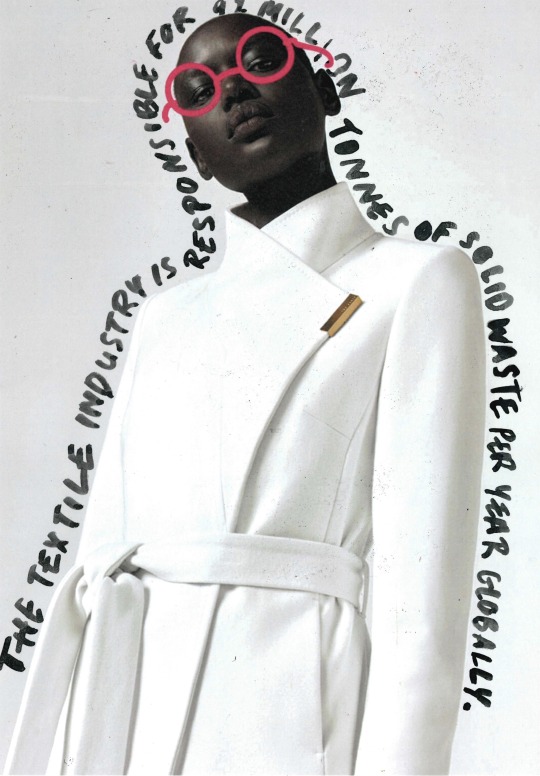
Then, I went on to fill the surrounding blank space with the same hand lettering and statistic. This was by far the most effective of the three, as it actually surprisingly made the model and garment the eye catching centre, allowing the clean, minimal garment to have all the attention with the words being something that needed a second glance.
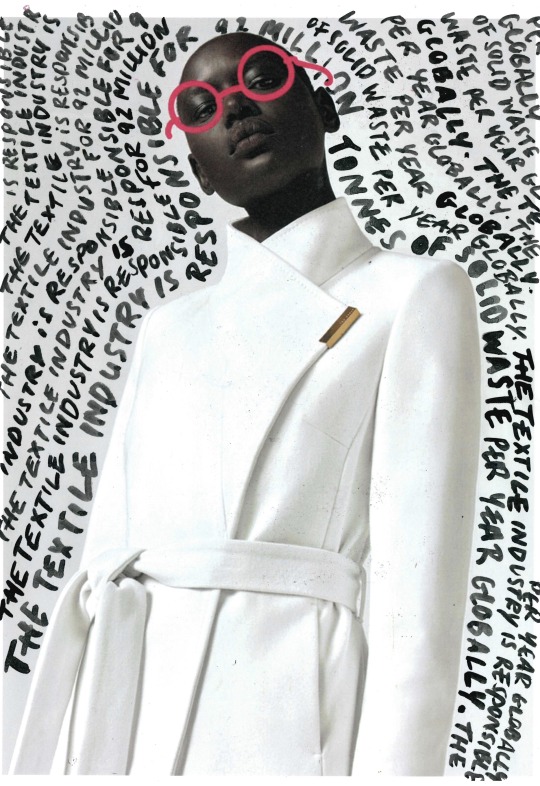
I tried to do the same again with a different quote - ‘77 million cotton workers suffer poisoning from pesticides each year’ on another fashion editorial - Horror Movie by Steven Meisel for Vogue Italia, April 2014; but not only did it not work anywhere near as effectively, I was also aware that I would have copyright infringement problems, so didn’t take this idea any further.
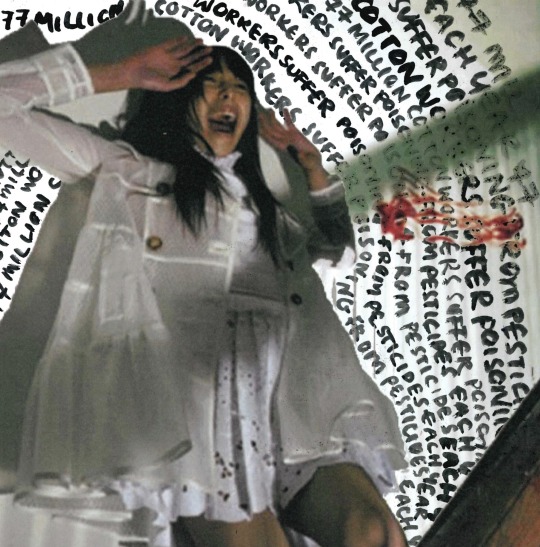
I returned back to my original idea, wanting to use it to almost produce my own advertising campaign against the textile industry. I came up with a pun - ‘it’s about time we cottoned on.’, implying that there is much more to the advert, and the audience/buyers of these textile pieces need to be aware of this. I added the quote to the bottom left corner, but still felt it seemed too minimal for the advert. Next, seen to the right, I changed the colour to match the glasses from the original editorial; which I felt was much more effective, and in turn I then wanted to continue to develop this style and idea further, incorporating the matching coloured font.
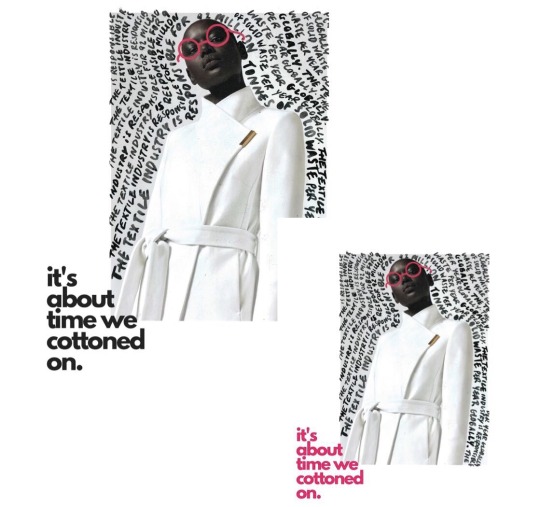
I tried using a different font - League Spartan in capitals (with letter spacing at -60 and line height at 0.9), with the original quote - ‘The textile industry is responsible for 92 million tonnes of solid waste per year globally’, as it would be easily missed in this composition due to the bold, large size of the pink text. This was very effective but I felt this original statistic was slightly too long, and I wasn’t sure if it made the hand lettered typography background pointless, as this quote says exactly the same thing and doesn’t put any other point across.
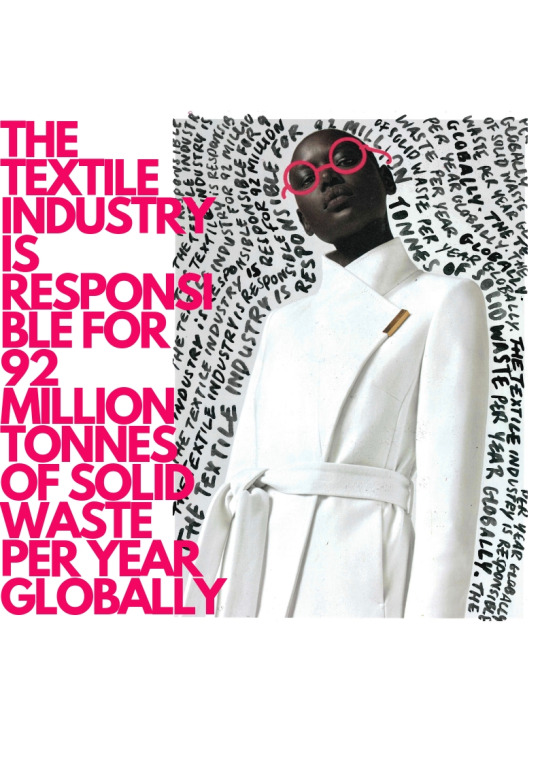
At this point, I returned back to the ‘it’s about time we cottoned on’ phrase and used a more linear composition, seen below. The first font (Bebas Neue) I tested seemed too thin and didn’t look serious enough - it was too stylish. I then tested a larger font, but at this point again realised it may be quite difficult to read the hand lettering as the bold pink heading took over.
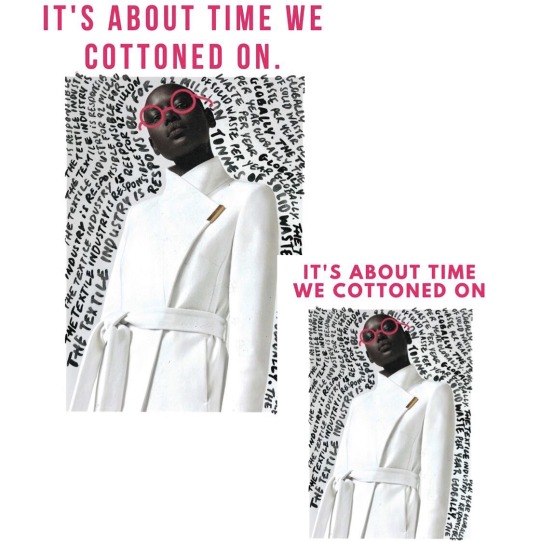
So now, I took my typography to photoshop, removing the background and leaving only the head (to allow me to line up the images perfectly) and the largest, boldest sentence from the hand lettering. I removed the ink using the magic wand tool, then added a background the same shade of bold pink as the glasses from the editorial. When placing this back onto the typography, I was then very pleased with the outcome as it made the key point of the typography stand out, and then would let me to return to my original advertising campaign styled compositions without loosing the whole point of the lettering.
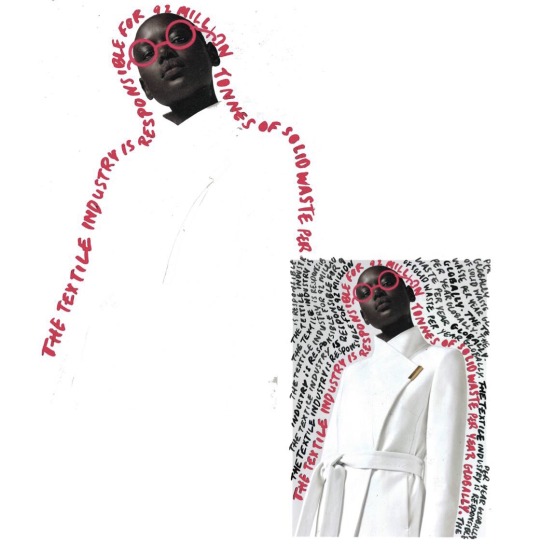
I did just that, returning first to the linear/headline styled compositions, testing font spacing and styles with the first pun, as well as testing with a different quote, which I didn’t feel worked, so now was certain to use the pun quote alongside my typography.
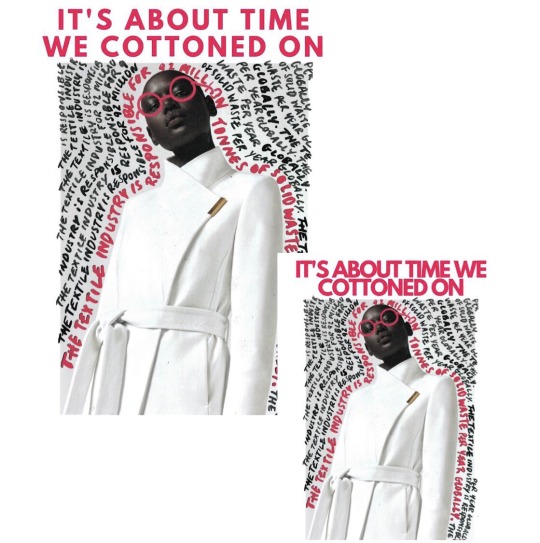
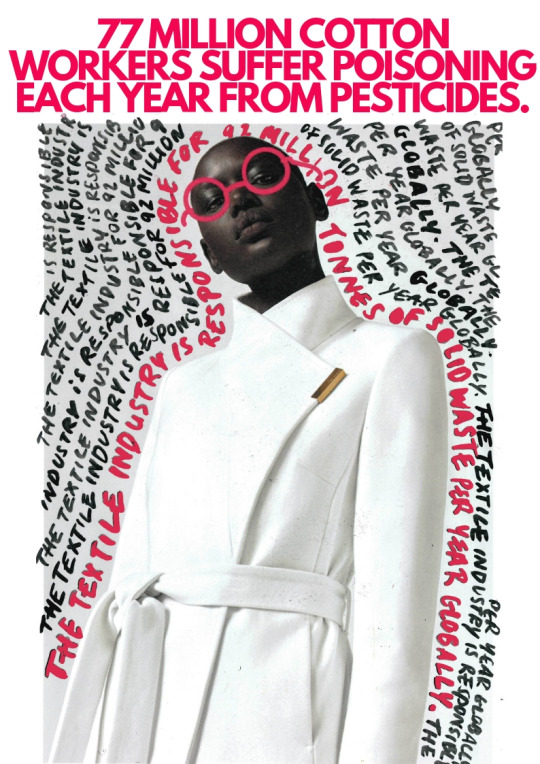
Finally I settled on the first pun quote, with the first font and the first composition in the style of a fashion magazine page.
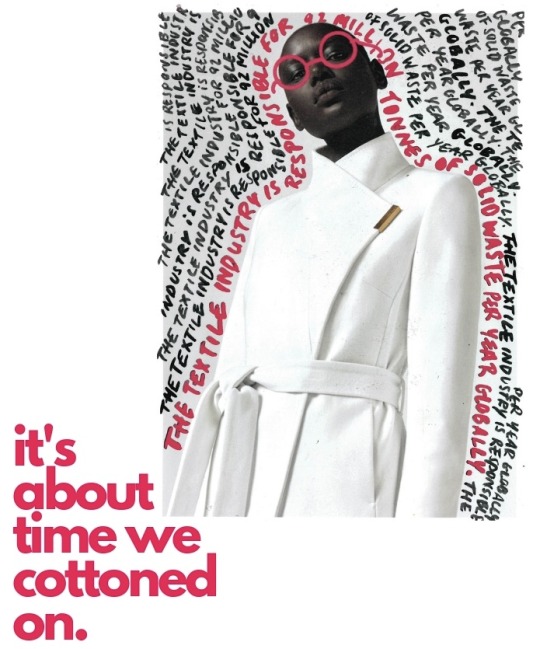
I was very pleased with my outcome, as I feel the juxtaposition between the fashion editorial, the fresh, clean garment and the guilt tripping typography and side quote is very effective and would make a very eye-catching piece of graphic design, especially in a fashion magazine.
Illustrating in Adobe Flash
Flash is a program that can be used to produce illustrations and is easier to use than Illustrator to create freehand illustrations using vector based tools. A Wacom Graphics Tablet is used to produce freehand illustrations and Flash can then also be used to animate our characters and illustrations as it was originally designed to create web animations with.
I used the brush and eyedropper tools on Flash to select areas of skin tone and shadow tones to produce the areas and highlights of the face. I was actually surprisingly pleased with the outcome, although Flash doesn’t allow you to blend colours very effectively, hence the almost impressionism style that I have ended up with. Whilst at first I didn’t like this, once I saw the overall finished product I was actually quite pleased and felt this style actually stood out and looked effective as it was so different to anything else I have done and looked more stylised.
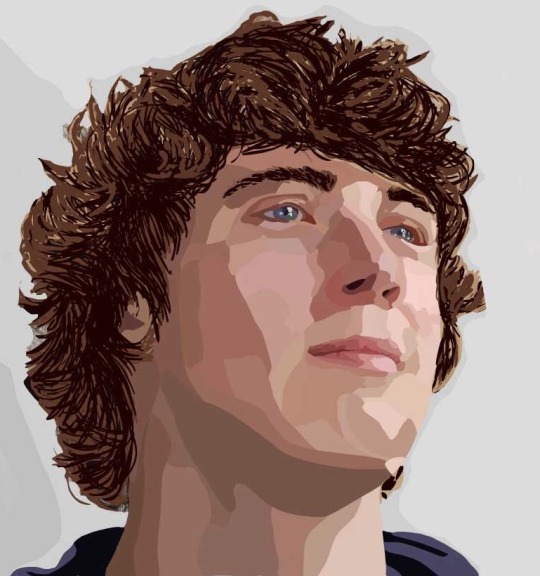
Surprisingly, I think I would actually return to Flash to illustrate with in the future, as it didn’t take as long as expected and actually brought a style to the work that I wouldn’t have otherwise explored.
Illustrating using Simple Shading and Paths in Illustrator
To produce an illustration using simple shading we simply created paths in illustrator and filled them with corresponding colours to the image below; using darker coloured shapes over a lighter coloured shape to produce highlights and shadows. Use of line is also important as anchor points control the shape of the curves.
After building up the leaves using the pen tool and filling with corresponding colours to those on the original photography, I then used the elipses tool to create tiny circles which I could build up as tiny details, following the speckles on the leaves both for shading and highlights, seen in the two screenshots below.
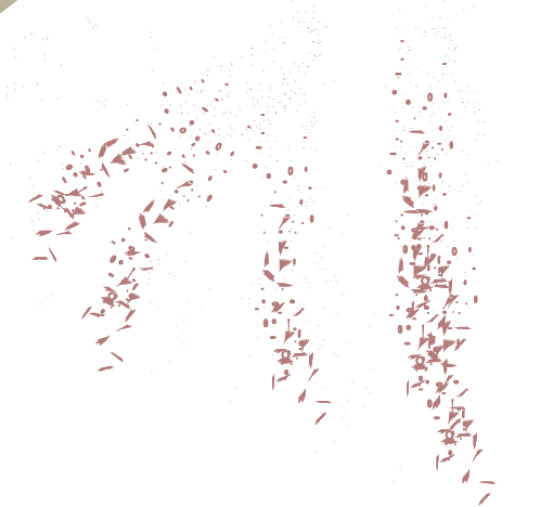
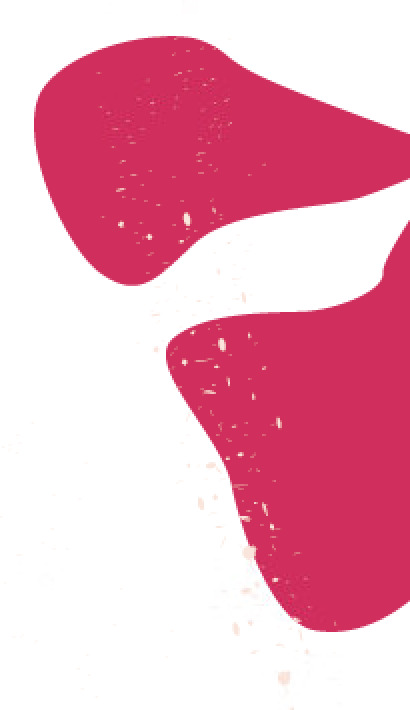
Below is the final illustration, where I chose to include the background also. I was surprisingly very pleased with the outcome, and felt that I managed to make it surprisingly detailed considering I was using such a simple technique in Illustrator. I would definitely use this technique again, perhaps to produce a base for a pattern (doing the same again but with the whole of the subject in view and without a background), which I could produce in Photoshop and then print onto fabric and manipulate further.
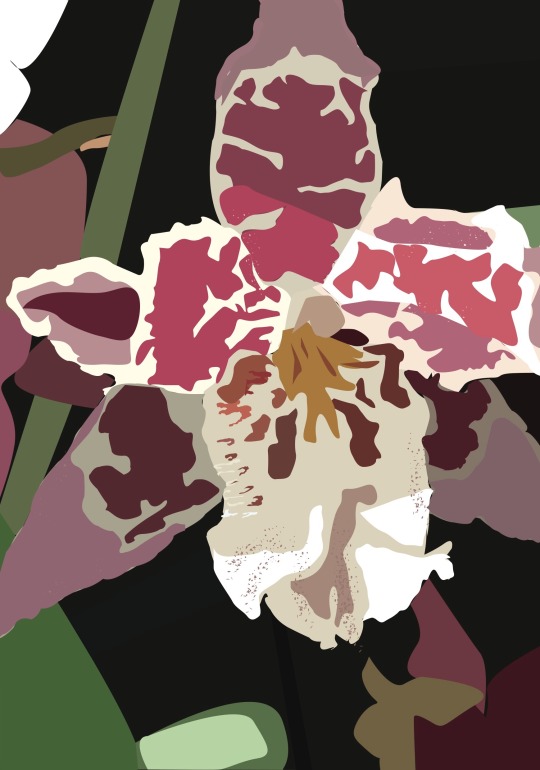
To develop this further, I took the Illustrator design into Photoshop and used blending modes and block colours to produce completely different colour ways and outcomes. Below is using the blending option ‘vivid light’, with a teal rectangle layer beneath the image. I liked the more muted, soft, pastel colour palette this outcome had and felt it was effective.
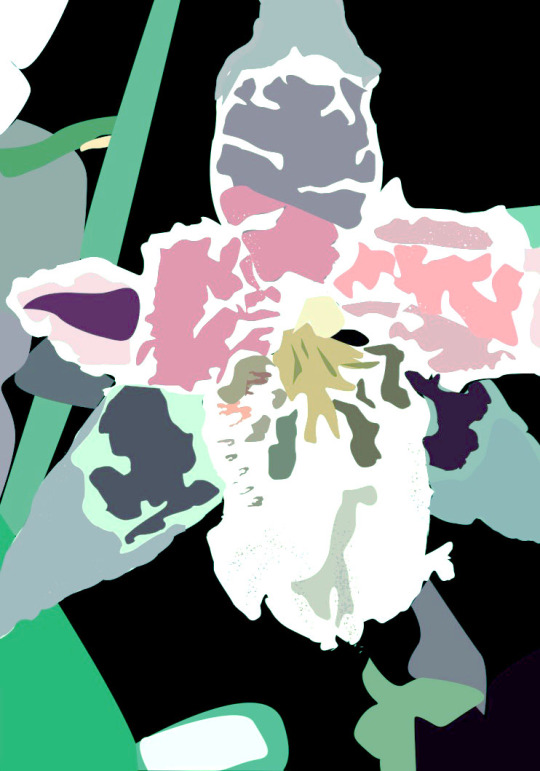
Again using the teal rectangle beneath the illustration, this is the ‘hardlight’ blending option, which provided a darker colour combination that on fabric could become more wearable than the one above.
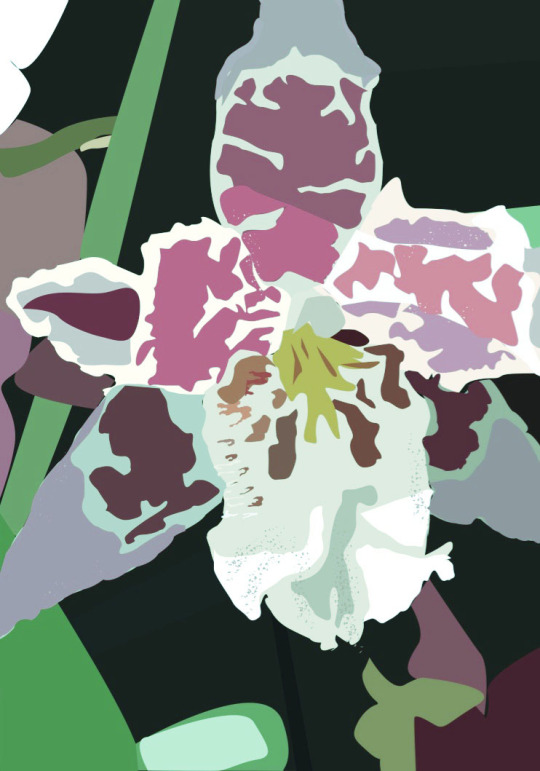
This time I tried an orange rectangle beneath the illustration with the ‘hue’ blending option. Whilst I was very fond of this strange and garish colour combination, I didn’t feel the image itself was effective, so although I may use this surprise colour palette again, I wouldn’t use this itself.
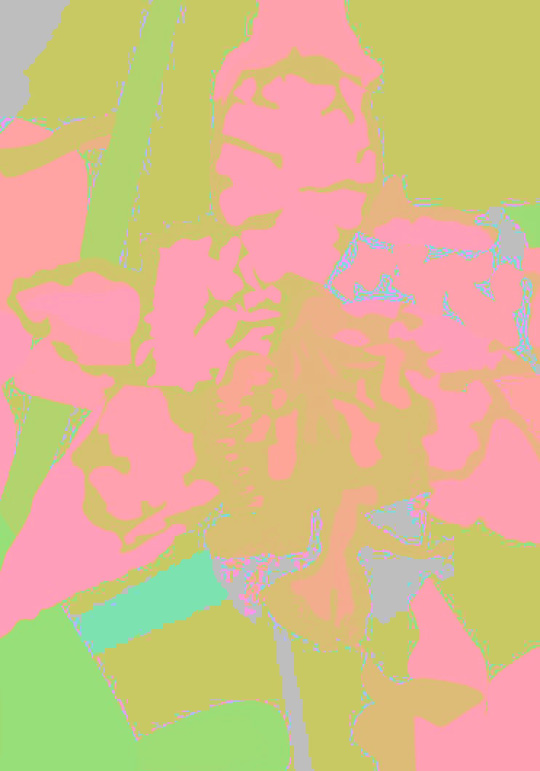
Using the ‘exclusion’ blending option with an orange rectangle, however, produced a completely different illustration, with a darker foreground and lighter, salmon coloured background. Whilst I felt this was interesting, I felt it was a bit too different and therefore probably wouldn’t use this again.
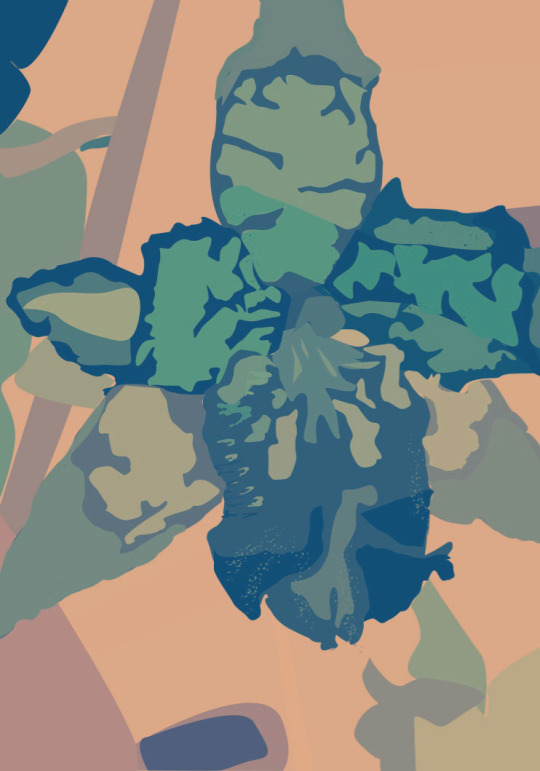
The ‘hardlight’ blending option with an orange background was very nice and the very vibrant and bold colour palette that came with it was very effective. I think this is one of the better and more effective outcomes that came from this Photoshop blending experimenting.
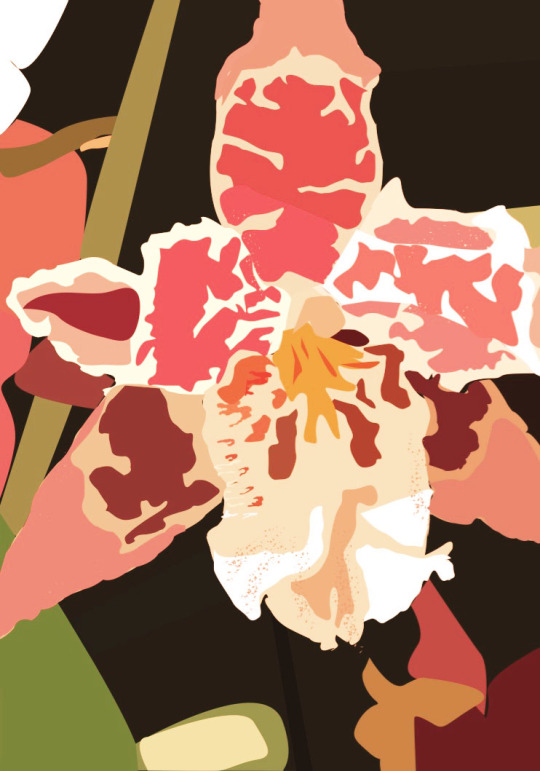
Using the ‘darker colour’ blending mode on a green background, however, didn’t look very nice at all and was too strange and alien like, therefore I definitely wouldn’t use this combination of layers with this blending mode again.
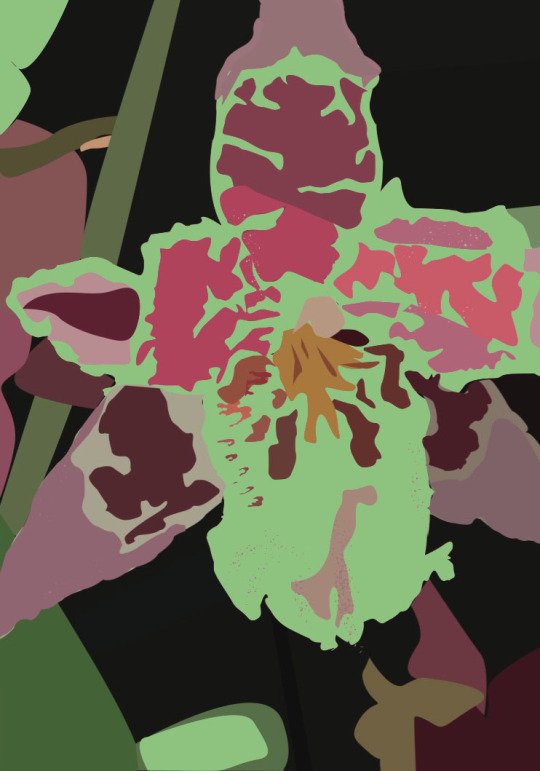
I did find that using a purple background with the ‘luminosity’ blending option was slightly effective, but wanted to keep testing as it didn’t appear interesting enough.

I felt the outcome of using the ‘hardlight’ blending option with a purple background was very effective, and the colours were much more effective than my original, but not too wacky and wild, which I liked a lot. I would use this version in further developments.
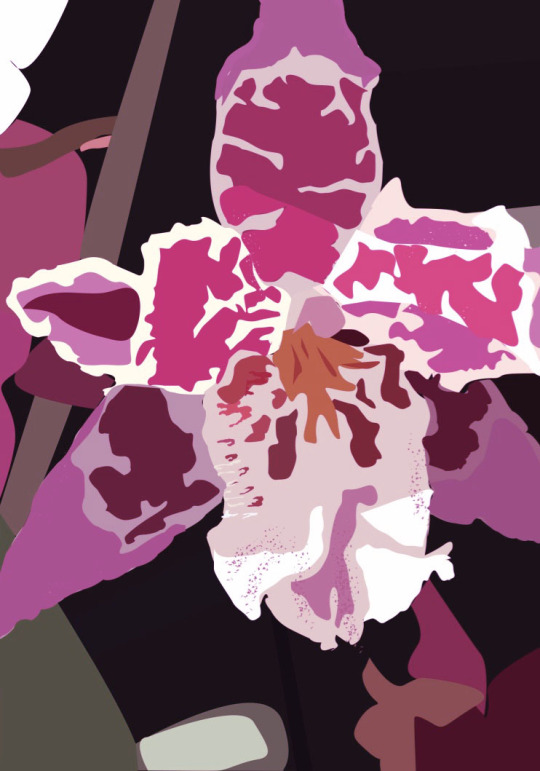
This was another firm favourite, using the blending option ‘vivid light’ with a purple background. These colours were much more vibrant, cool toned and interesting, and therefore very effective so I would definitely also use this colour palette and this blending mode again.
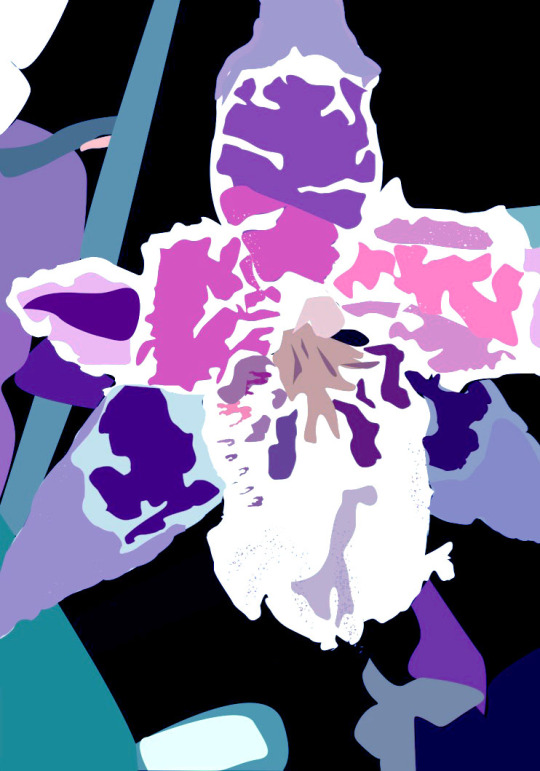
Likewise to the orange, using the ‘hue’ blending option with a pastel yellow background produced a very pleasing yet strange colour palette, but the illustration itself can’t be seen therefore I wouldn’t try this again or use it any further other than just for the colour scheme.
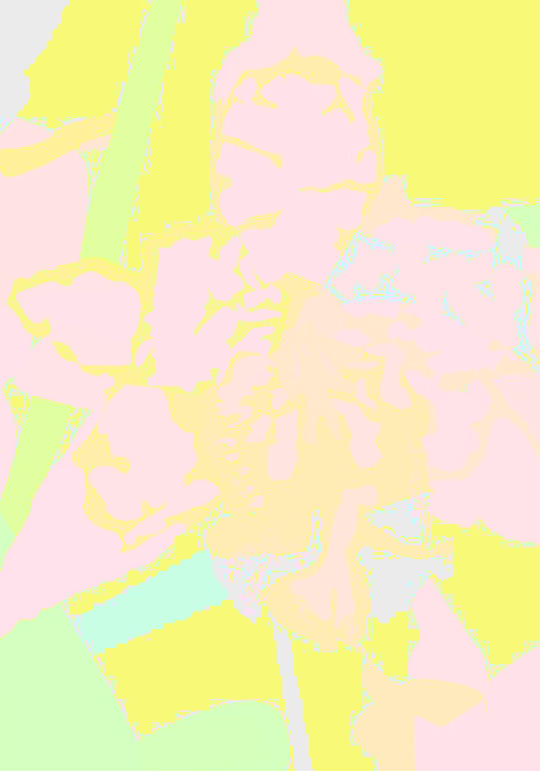
With the original illustration, I then added a layer of leaves using the Photoshop shape tool, which I then used the ‘luminosity’ blending option on, which removed the colour from where the leaves were, which I felt was very effective and I wanted to play and experiment with further.
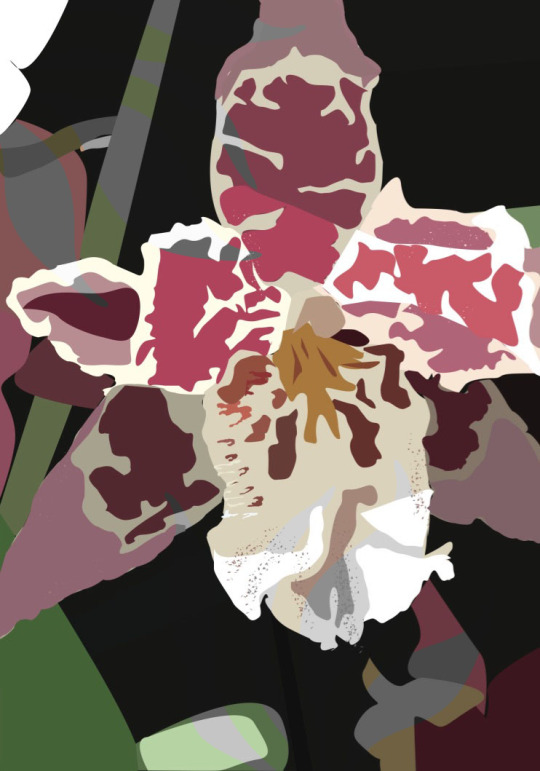
I then tried the ‘pinlight’ blending option on the leaves, which I liked even more so than the ‘luminosity’ option as it made these areas lighter and more eye-catching as oppose to removing the colour from them.
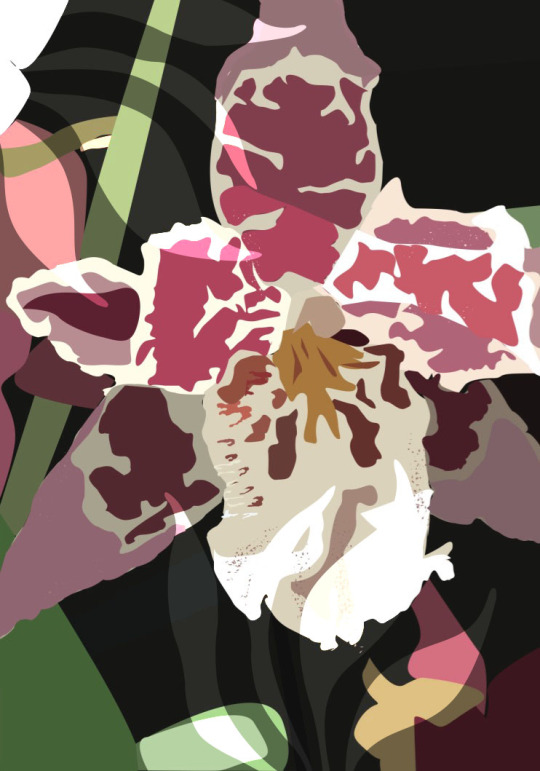
Using ‘subtract’ with the original illustration alone was different and effective, so I would experiment with this further.
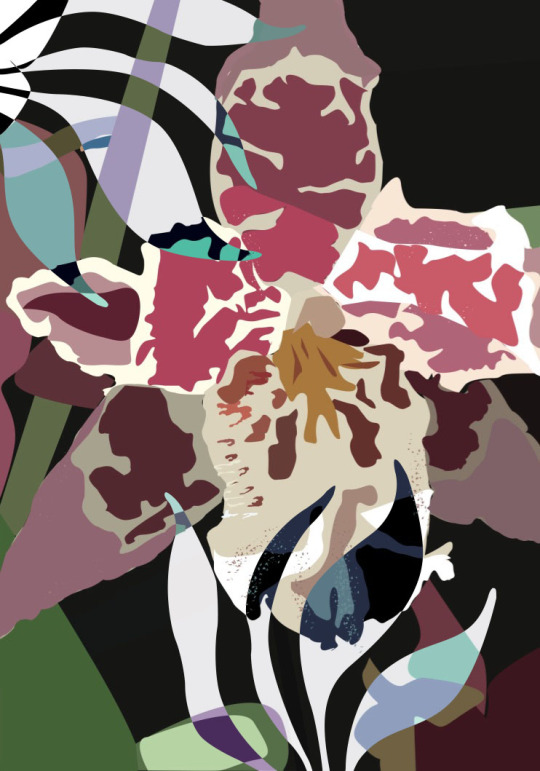
Using the ‘subtract’ blending option on the leaves, this time with a teal background produced a strange underwater aura which I didn’t really like, therefore I wouldn’t use this combination again.
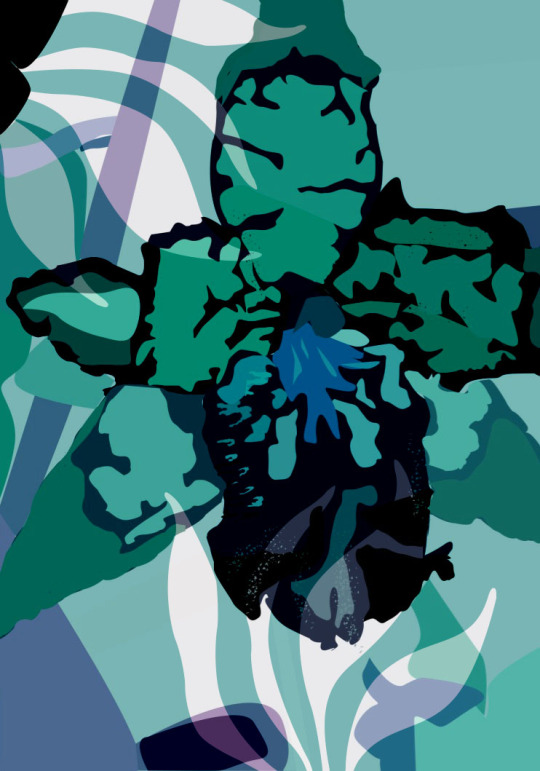
At this point, I expanded on the leaves idea, using the original ‘hardlight’ purple piece, with my own scanned in inked leaf overlay, which I felt looked very effective and added a great deal of texture which I think added more form to the piece.
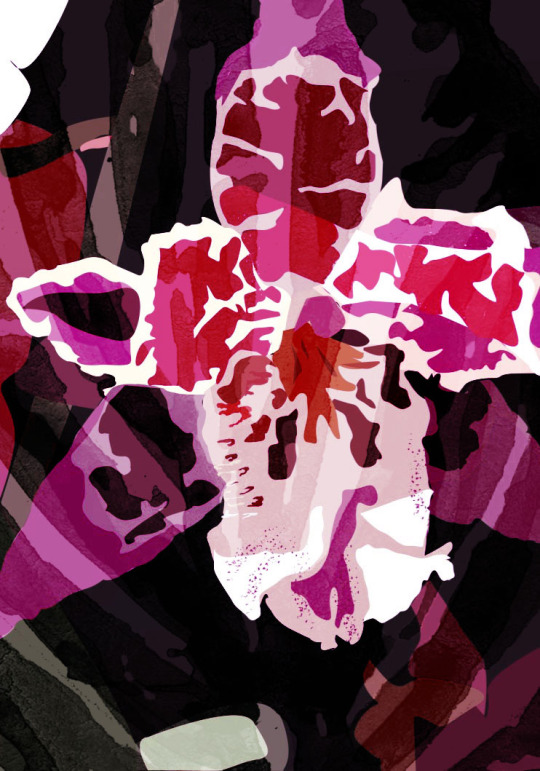
Again, using the original ‘hardlight’ purple piece, with my own scanned in ink leaves overlaid, using the ‘colour’ blending option. I really liked this and thought that it was effective as the leaves actually provided an extra depth and a separate print.
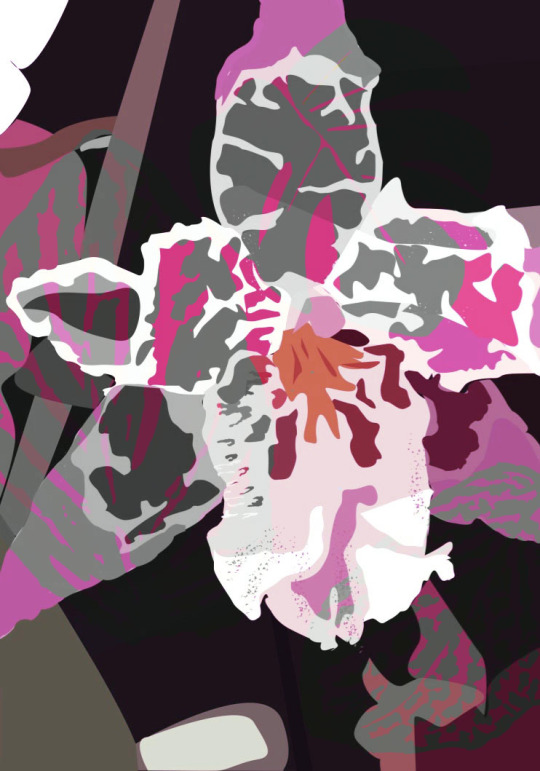
Using the original ‘hardlight’ purple piece, with my own scanned in inked leaf overlay again, this time using the ‘colour dodge’ blending option, which added a lot of texture to the piece which I thought was really effective and therefore I wanted to take this further.
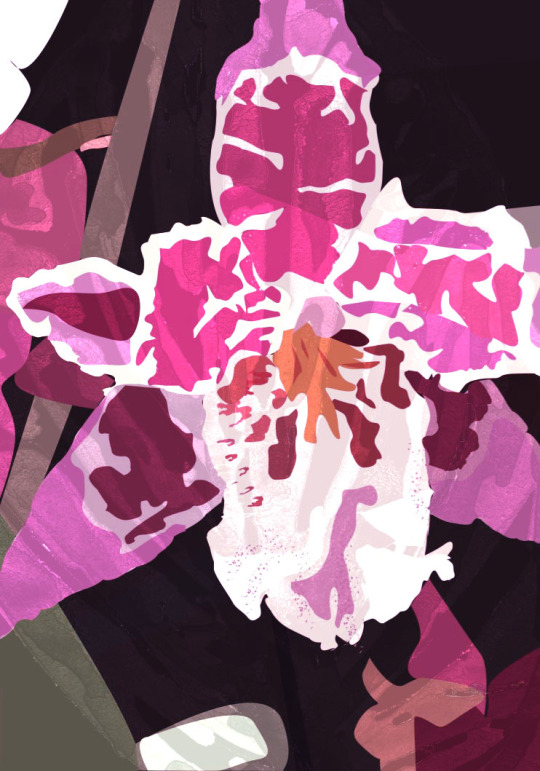
I did the same again, this time using the ‘difference’ blending option, which did the same again but darker, which I liked even more.
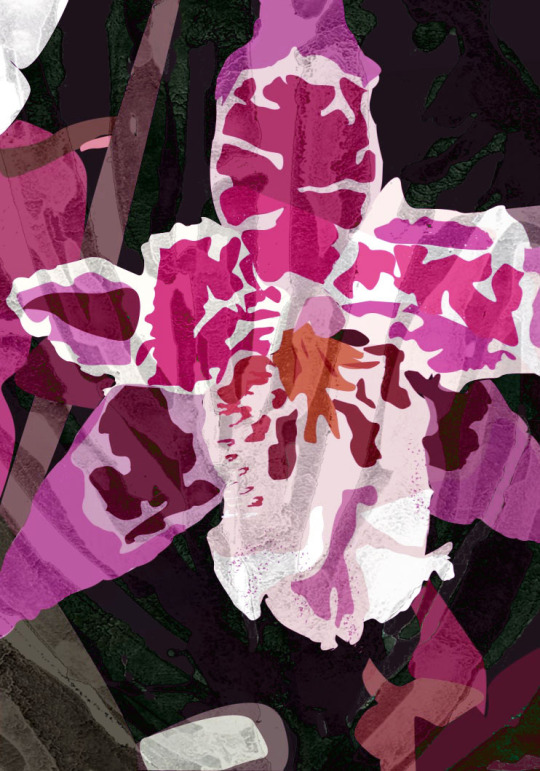
From here, I used the ‘hue’ blending option, which I felt was really effective as it completely changed the colour of the leaves to green, which was a very effective contrast against the pink and I was very pleased with this colour palette.
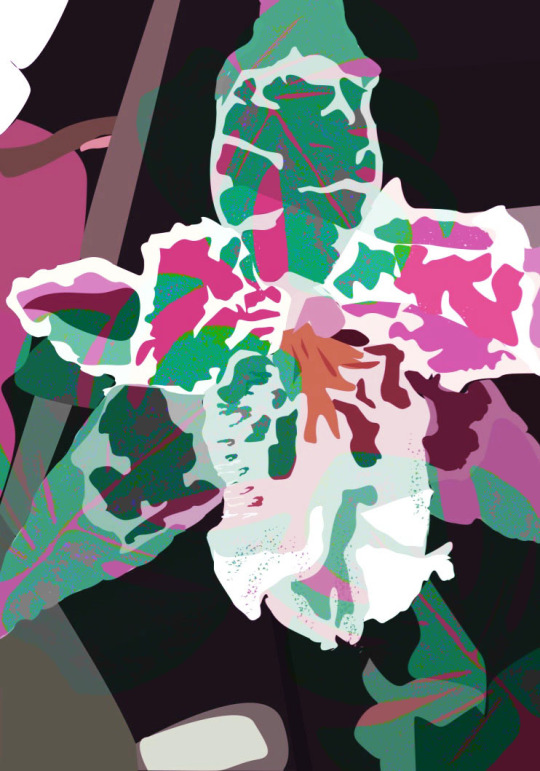
At this point, I expanded my previous knowledge and workshops, using the original ‘hardlight’ purple piece, with my own scanned in inked leaf overlay, and produced a pattern with it.
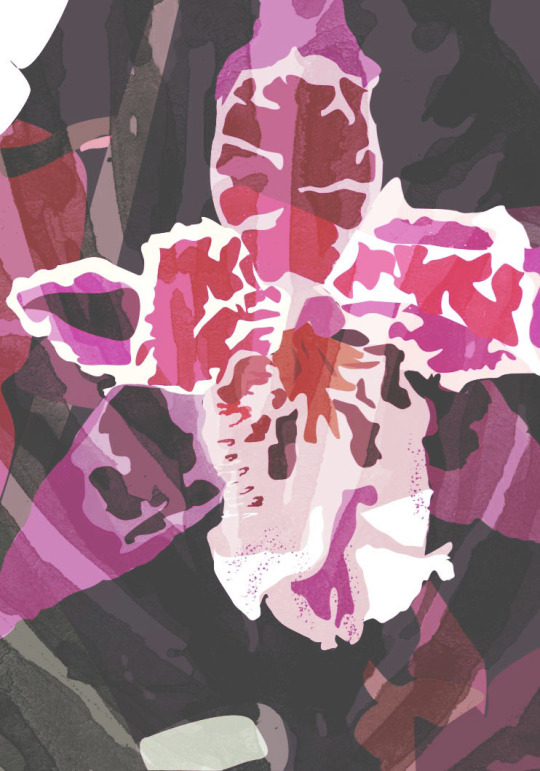
I produced a mirror repeating pattern, seen below, by copying the image above, pasting it and flipping it vertically, then doing the same twice again and flipping the two horizontally. At this point, I had a tile and just needed to produce the repeating pattern using the previous method.
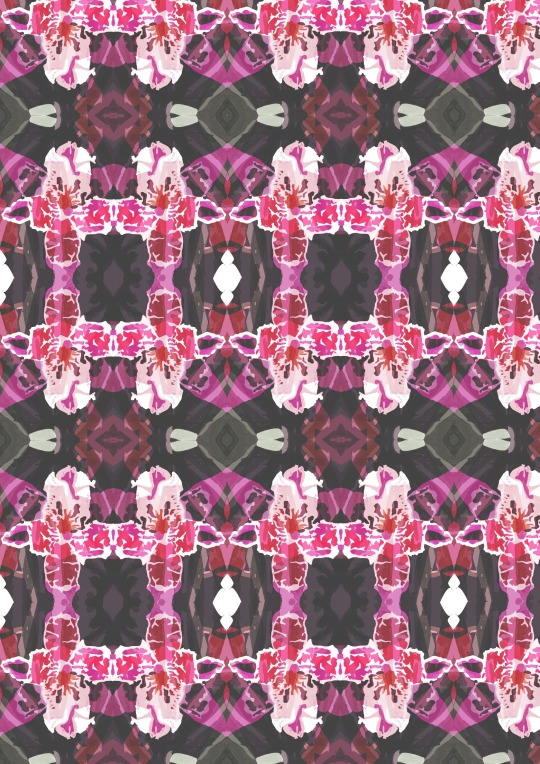
I was very pleased with the outcome of the pattern and wanted to take it further so decided to produce some mockups, as this was something I had knowledge of and had done in my own time before. I started first with wallpaper, which I felt was very effective as the print was bold and colourful but still somewhat sophisticated.
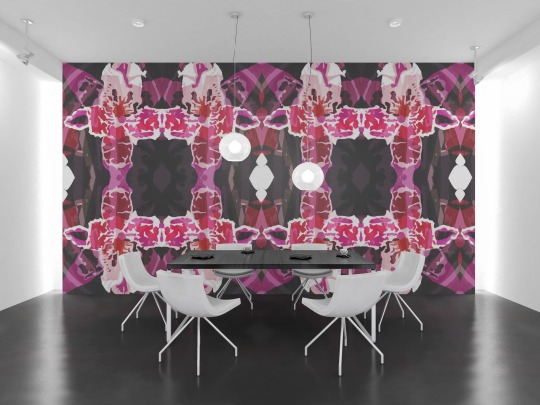
Here I used a different setup - creating my own mockup (as oppose to using a pre-made PSD file template like the one above) using Sarah Dorweiler’s image from Unsplash, a free high quality image site.
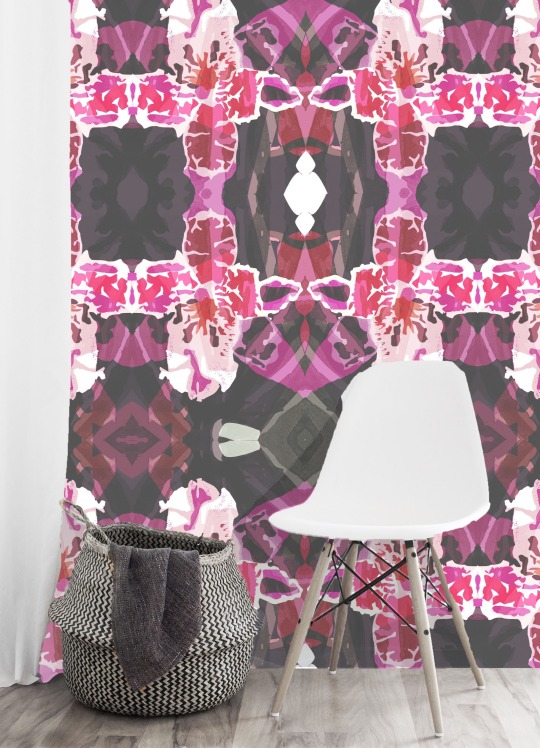
I was so pleased with this outcome again, that I wanted to branch further and tested it as a wrapping paper roll, seen below.
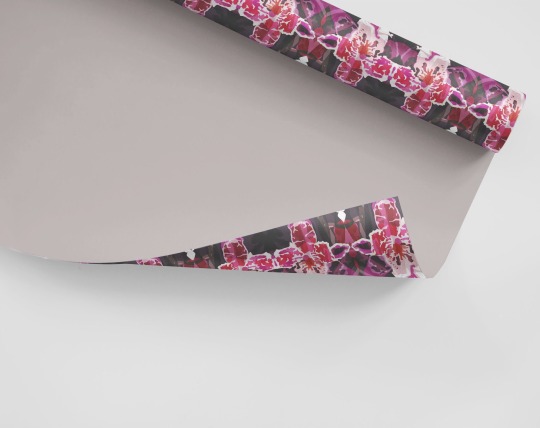
Finally I then used a gift wrapped mockup template, which I felt was by far the most effective. This was also partly due to the texture of the paper itself. I really loved seeing my pattern look so professional and sophisticated, which has heightened my love for surface and pattern design even more and therefore I will definitely be doing this for future projects.
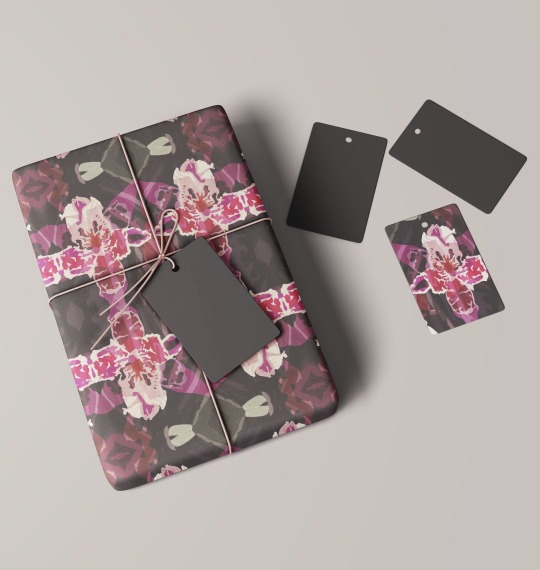
From here I also wanted to test the print on actual fabric, so used the same technique as explained in the Textiles workshop, putting the fabric through the wax printer, except this time I wanted to use a fabric other than plain white cotton. I chose a purple/grey cord fabric, and firstly tested printing just the tile alone onto it. Whilst the printing itself actually worked, although I didn’t expect it to, the print was too dark and didn’t look effective due to the colour of the fabric beneath the print; and this can be seen in both images below, where I also tried the same again with the pattern as oppose to just the tile.
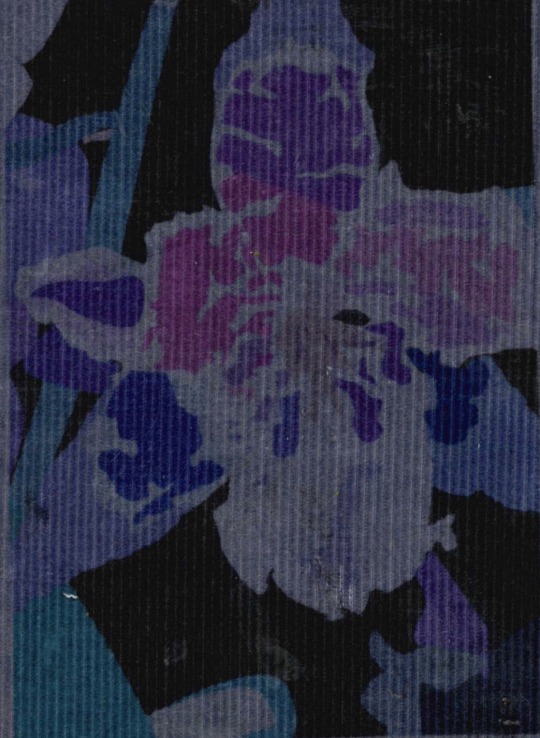
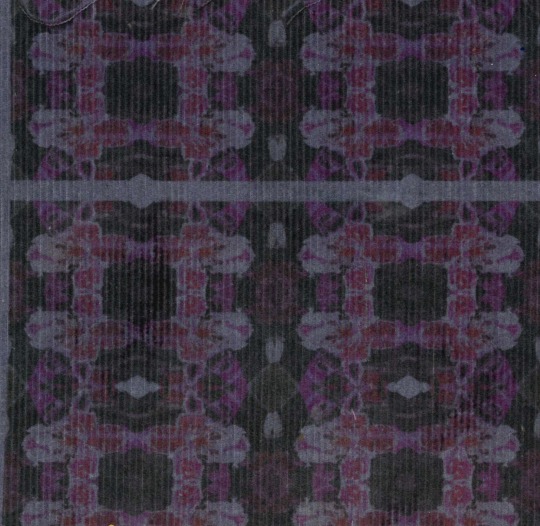
At this point I decided to bleach the fabric, and did this to two different types of fabric; however when bleached the first went an orange/red tone instead of white or lighter blue, so I decided on the second fabric.
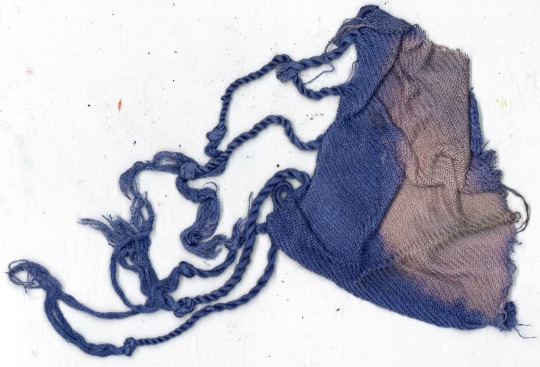
Here, I continued to bleach the fabric 4 times until it was as light as possible.
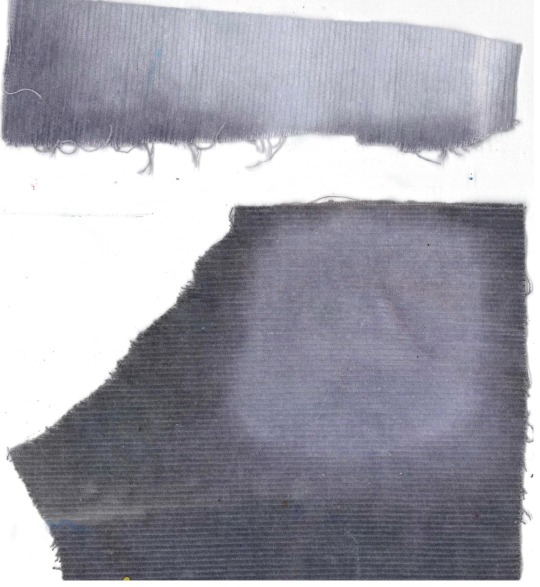
This worked considerably better and I was very pleased with the outcome, seen below. I felt the extra texture it gave was effective and luxurious.
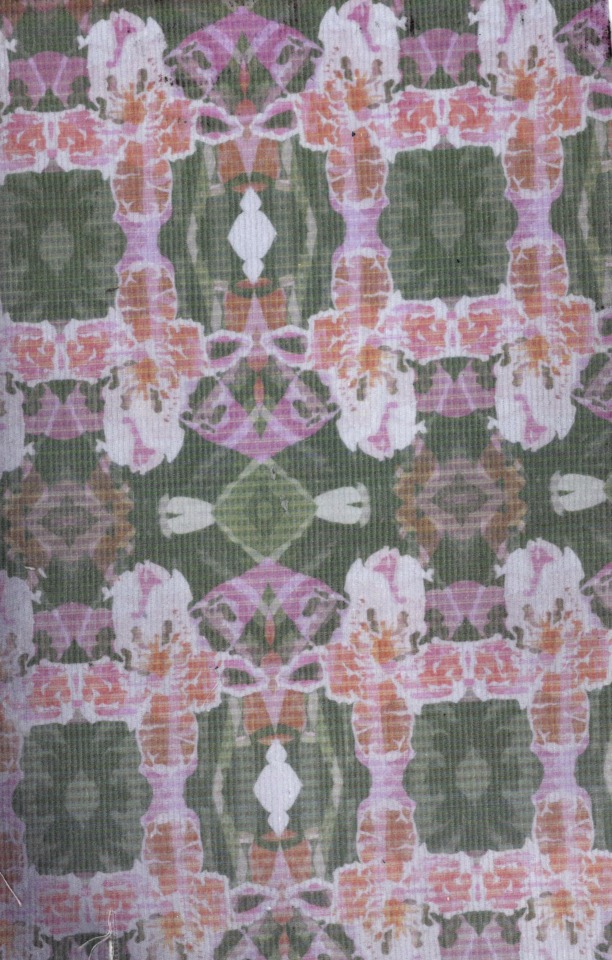
I did this a final time with just the tile and found it just as effective due to its’ bold and vibrant colour palette.
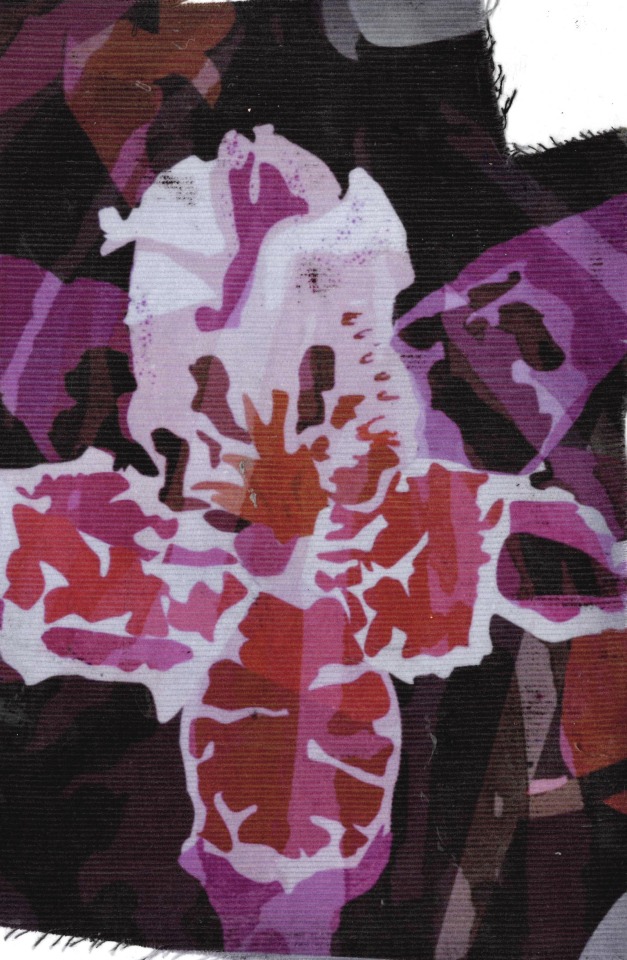
Overall, I would definitely continue to blend and intertwine my knowledge from these illustration workshops and the textile workshops throughout the rest of the course as this is where I am happiest, able to experiment and most pleased with the outcomes.
0 notes